Competency Area 4: Management of Arthropods
PO 27. For each of the following arthropods:
A. Be able to sight identify.
B. Classify as an important economic pest or a sub-economic/occasional pest.
C. Classify by feeding habit, host range, injury mechanism, symptoms and damaging stage(s).
D. Understand how biology influences management
E. Know how environmental conditions influence population dynamics.
F. Know how the environment influences potential for crop damage.
Arthropods of Corn
Western/Northern corn rootworm
European corn borer
True armyworm
Fall armyworm
Black cutworm
White grub
Wireworm
Corn leaf aphid
Grasshopper
Seedcorn maggot
Slugs (not insects)
|
Alfalfa
Alfalfa snout beetle
Alfalfa weevil
Alfalfa blotch leafminer
Clover root curculio
Pea aphid
Potato leafhopper
|
Small Grains
Cereal leafbeetle
Wireworm
|
Soybeans
Soybean aphid
Spider mites
Seedcorn maggot |
ARTHROPODS OF CORN
Western/ Northern Corn Rootworm
|
click on images to enlarge |
| Pest Type: Primary pest |
|
| Feeding Habit, Host Range, Injury Type, Symptom, Damaging Stage: |
|
Lifecycle: Adults lay eggs in soil cracks in existing corn fields during August and early September. Eggs over winter in the soil until mid-May the following spring. Eggs hatch over about a 4 week period from mid-May until early June depending on the soil temperatures. Newly hatched larvae must find a corn root within 24-48 hours in order to survive. Newly hatched larvae are also prone to drowning if heavy rains waterlog the soil during this time period. Larvae feed on corn roots until mid-July in most locations. Mature larvae pupate in the soil and emerge as beetles in synchrony with pollination. Adults feed on pollen and leaf tissue during the 3-week period required for mating and egg production. Eggs are laid in the soil cracks around the base of corn plants during August and September until the killing frost with most of the eggs laid prior to September 1.
The primary host range of this insect is corn, including both field corn and sweet corn. The primary damaging stage is the larvae in the soil, feeding on the roots of the corn plant. Feeding larvae with their chewing mouth parts consume and clip off roots, interfering with the uptake of water and nutrients. Brace roots are also fed upon, causing the plant to tip over and lodge. Maximum larval damage and plant lodging usually occurs around or shortly after pollination when the plant is undergoing grain fill. Economic losses from this insect are both reduced yield from plant stress during grain fill and harvest losses from lodged plants failing to be harvested by the silage chopper or combine. Since eggs are laid in August in existing corn fields, the risk of an economic rootworm population increases the longer a field is planted to continuous corn. Based on the insect lifecycle, first year corn is seldom at risk under the current situation in NY and the NE US. In the Midwest corn belt, where annual rotation of corn and non-host crops have been the widespread agricultural practice, rootworm has adapted with extended diapause (hibernation) crossing more than one year and a behavioral adaptation where eggs are laid in soybean fields rather than in corn fields. These strains are not currently found east of Ohio and pose little risk under the current agricultural production practices. As noted below, second year corn has increased risk over first year corn and the risk increases as the years of continuous corn rise. |
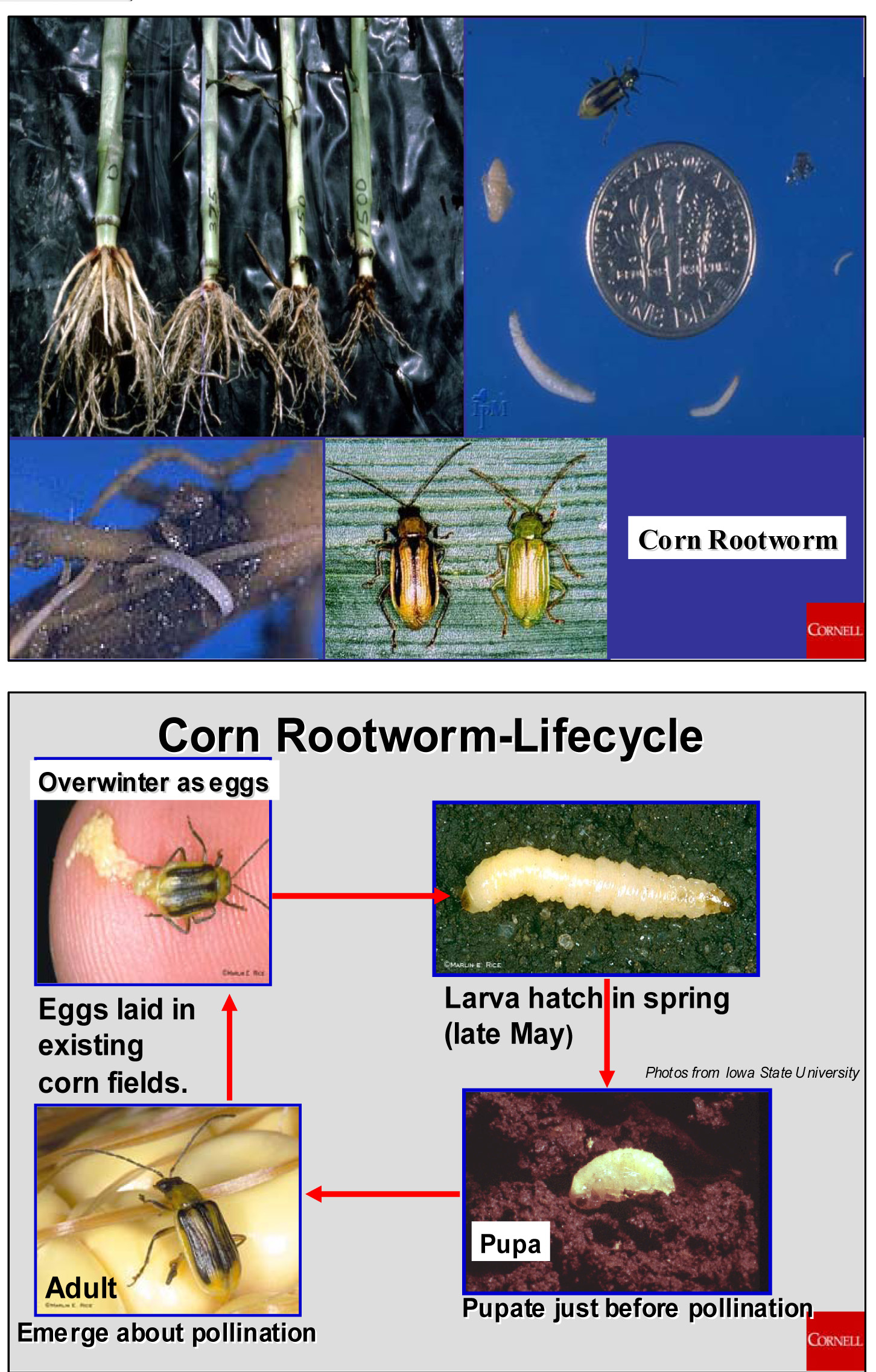 |
Impact of Environment on Population Dynamics: Since this insect has only one generation per year, environmental impacts are focused sole on the effect on the single generation, not the impact on the number of generations per year as with other insect pests. Water saturated soils during the larval hatching period (late May-early June) causes a high level of mortality to the young larvae, often resulting in a sub-economic population. Droughty soils, during the hatching period, can also cause high larval mortality to the newly hatched larvae in search for the first corn root. Once a root has been located, dry soil conditions have little impact on the larvae. High soil temperatures can speed up larval development, resulting in an earlier adult emergence in July.
|
| Impact of Environment on Crop Damage: Since the larval feeding removes roots critical to the pollination and grain filling phase of corn production, dry soil conditions increase the impact of root removal through increased water stress to the plant. The increased water stress is often reflected in reduced grain yields. In growing seasons with adequate soil moisture during the grain filling phase, the impact of root removal is lessened because the plant is able to regenerate roots and recover from the rootworm feeding damage. |
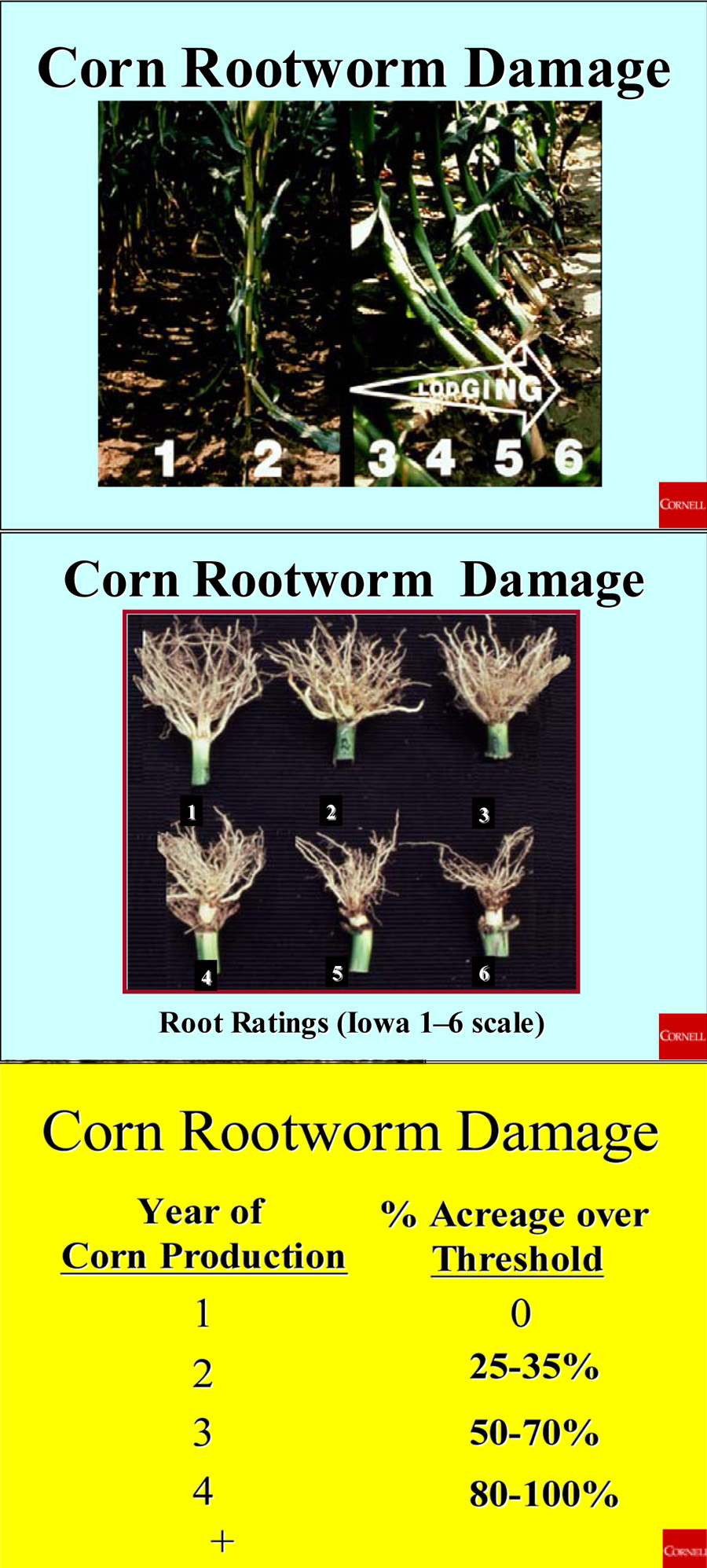 |
| Management: Corn rootworm populations are managed by managing the larval populations. This is accomplished by removing the food source (rotation) or killing the larvae before damage with a soil insecticide (granular or seed treatment) or a genetically modified corn plant where the rootworm active toxin is incorporated into the genome of the corn plant and expressed in the root tissue. Since this insect has a documented ability to adapt to toxins by developing resistance, attention needs to be paid to resistance management strategies to preserve the effective technologies and reduce the probability of resistance development. |
European Corn Borer
|
|
Pest Type: Secondary Pest Status in NY, Primary Pest Status in portions of the Midwestern Corn Belt. |
|
Feeding Habit, Host Range, Injury Type, Symptom, Damaging Stage: There are three different bio-types of European Corn Borer in New York. Biotype 1 has only a single generation per year and primarily attacks either field or sweet corn. Biotype 2 has two generations per year and primarily attacks either field or sweet corn. Biotype 3 has two generations per year and attacks a wide array of plants including corn, wheat and peppers. |
Lifecycle: Mature larvae overwinter in the corn stalks left in the field after harvest. During the early spring, these larvae pupate and become moths which chew out of the stem and emerge during late May and early June. After mating, the females lay eggs in masses on the underside of corn leaves (1st generation) near the midrib. After hatching, larvae feed for a short period on the corn leaves before migrating into the whorl where they bore into the stem where the remainder of larval development is completed.
In the single generation biotype, these larvae remain in the corn stalk until the following spring when they emerge as moths. In the two generation per year biotypes, the first generation larvae pupate and emerge as moths in late-July. After mating, the female moths lay eggs around the developing ear. After hatching, the newly emerged larvae bore into the ear and ear shank where they develop. After maturity, the second generation larvae remain in the corn plant throughout the winter and emerge the following spring.
All economic feeding damage is caused by the larval stage feeding on the plant and fruiting structures.
Since the larvae have chewing mouth parts, the feeding damage is direct tissue removal of the leaves, boring into the stem of the plant and feeding on the reproductive portions of the plant. Economic losses result from reduced yield, damaged fruits and the introduction of fungal rots into the feeding wounds and entry holes into the plant stems. |
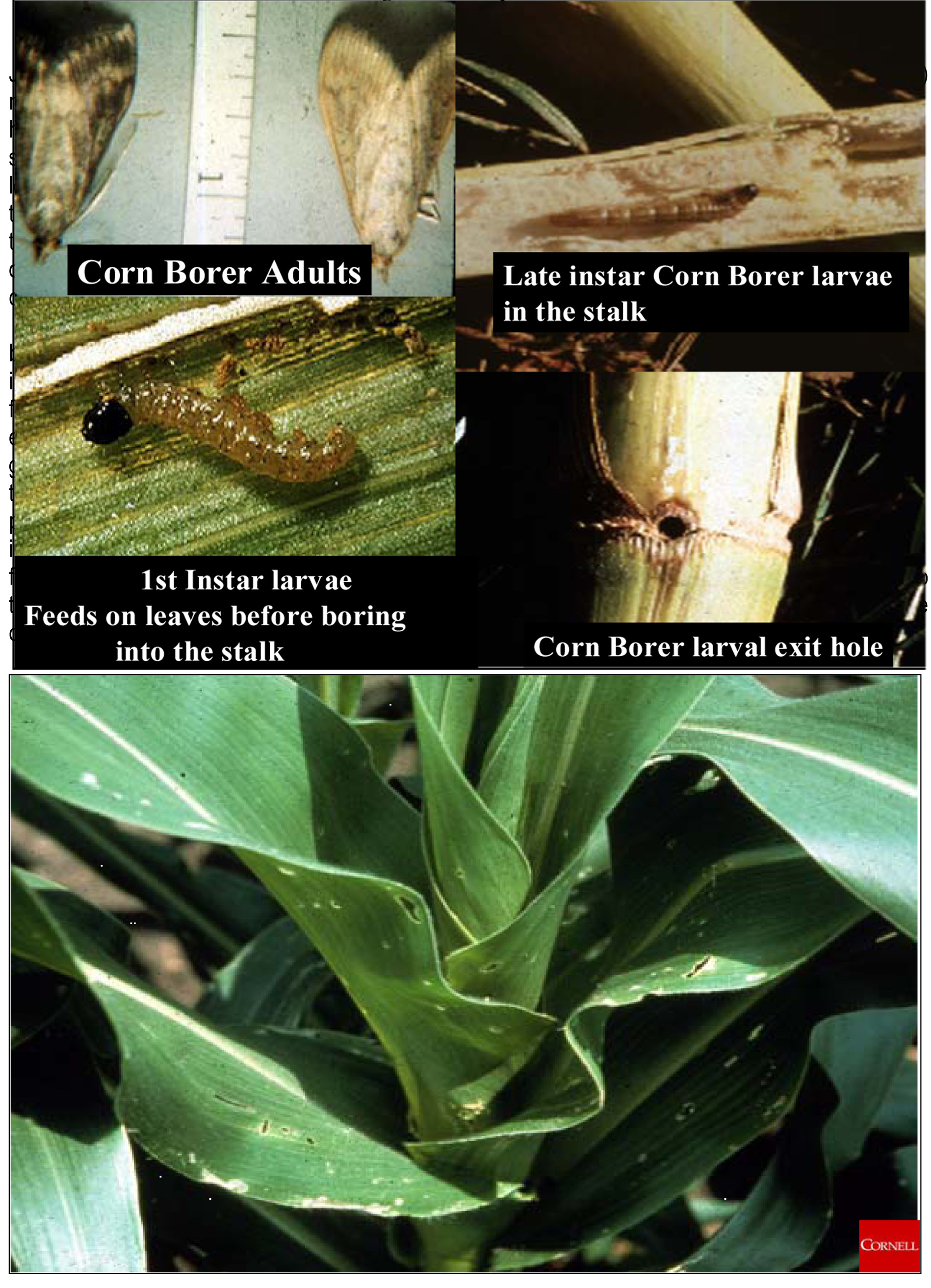 |
Impact of Environment on Population Dynamics:
Since eggs are laid on the underside of the leaves and the young larvae feed on the leaf surfaces before boring into the plant, hot dry conditions cause a high larval mortality among small larvae before they bore into the stem of the plant. Since these small larvae move into the corn whorl to bore into the plant, a timely rain storm which fills up the corn whorl also causes mortality to the individuals located in the whorl. Higher temperatures during the growing season will accelerate insect development but the insect will not add an additional generation during the hot years because overwintering diapauses (hibernation) is triggered by the decreasing day-length during August when the second generation is developing in the stalk.
|
Impact of Environment on Crop Damage:
Stalk feeding and ear feeding by corn borer larvae weaken the stalks and the ear shanks causing stalk breakage and ear drop prior to harvest. Damage is increased by strong winds in late summer and early fall before harvest. Yield can be impacted by the severing of the vascular bundles within the stalk during boring and feeding, interfering with the movement of water and photosynthesis. Crop yield and standability is also impacted with the introduction of stalk rot organisms into the corn stalk through the feeding wounds caused by the larvae entering and exiting the stalks. |
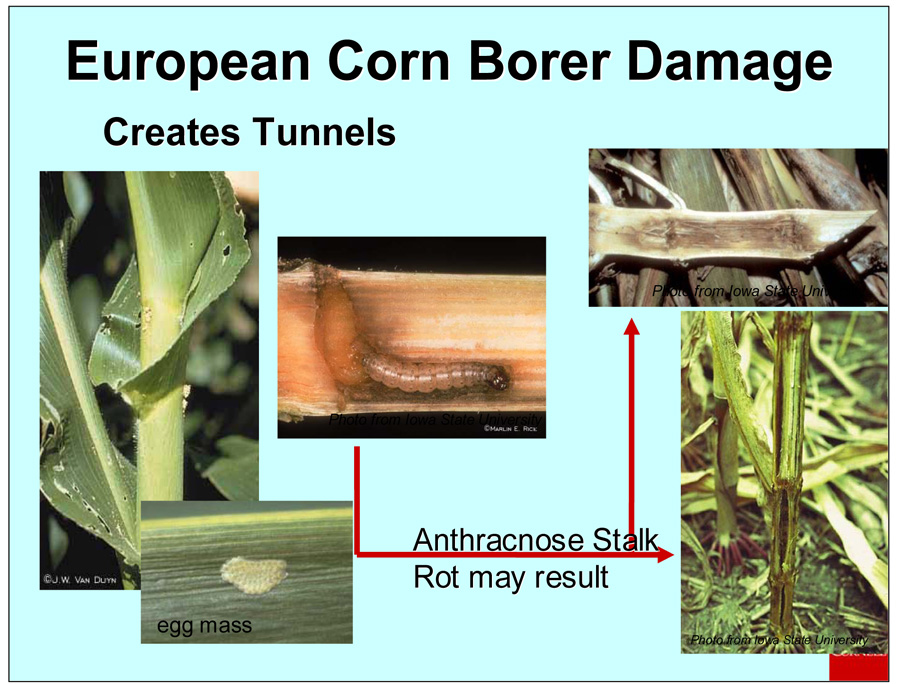 |
Management:
The only effective management of corn borer is the use of corn varieties where the corn borer effective toxin is incorporated into the plant genome and expressed into the above ground portions of the plant.
Since corn borer is a localized and sporadic problem in NY, widespread and prophylactic use of the technology is not recommended. It is recommended in situations where producers suspect a high probability of an economic problem based on historical evidence. |
True Armyworm
|
|
Pest Type: Secondary |
|
Feeding Habit, Host Range, Injury Type, Symptom, Damaging Stage: |
|
Lifecycle: Armyworm is a long-ranged migrant with the overwintering area in the southern states. Migrant moths invade the northern ranges in the spring aided by the fast moving southerly winds along storm fronts.
Spring migrants typically arrive between mid-April and mid-May. The magnitude of the migration into
New York and the Northern Eastern US variable and is dependent on population buildup in the southern states and the direction of the southern winds during the time of peak moth migration. In the late summer-early fall, newly emerged moths return to the southern states in a long-ranged migration utilizing the northern winds immediately following the passage of a weather low pressure front to aid their migration.
Newly arrived spring migrant moths lay their eggs in grass hay fields, grass waterways or weedy patches in last year’s corn fields. Eggs hatch in 7-10 days and the newly hatched larvae feed on the grassy plants. During the larval stage, the larvae pass through 6-7 molts with each larval stage a significant increase in size. Eighty percent of the foliage consumed by the growing larvae occurs during the final larval stages. In areas where large numbers of migrant moths arrived, entire grass fields are frequently consumed and the mid-sized to large larvae start migrating to find new food sources. These mass larval movements are the source of the name of armyworm. Invading larval marches will move into adjacent corn fields, grass hay fields or other areas, feeding as they go, causing significant economic damage. These large larvae which are migrating will usually finish their larval stage within 7- 10 days and enter the soil where they pupate and change into moths. The entire lifecycle during the warmer months require approximately 30 days from egg to moth.
Armyworms have 3-4 generations in the northern regions of the US, but are a significant economic problem only during the first generation in areas of concentrated migrant moth arrival and associated egg laying. Subsequent generations are low in concentration due to the migrant behavior of the newly emerged moths and the vast grassy habitats throughout the northern regions (grassy hay fields, grassy roadsides, waterways, lawns). In the fall, newly emerged moths return to the southern states for overwintering on the weather fronts with winds from the north. Armyworm does not overwinter in the northern states.
Feeding damage is caused by the larvae equipped with chewing mouth parts. Feeding damage is therefore tissue removal and defoliation. Armyworm larvae feed primarily on a wide array of grasses which include all pasture species and corn. The main symptom of feeding damage is the defoliation and loss of leaf tissue. In pasture grasses, the entire blade is consumed. In the larger leaves of corn, the main leaf rib is frequently left after the remainder of the leaf has been consumed. |
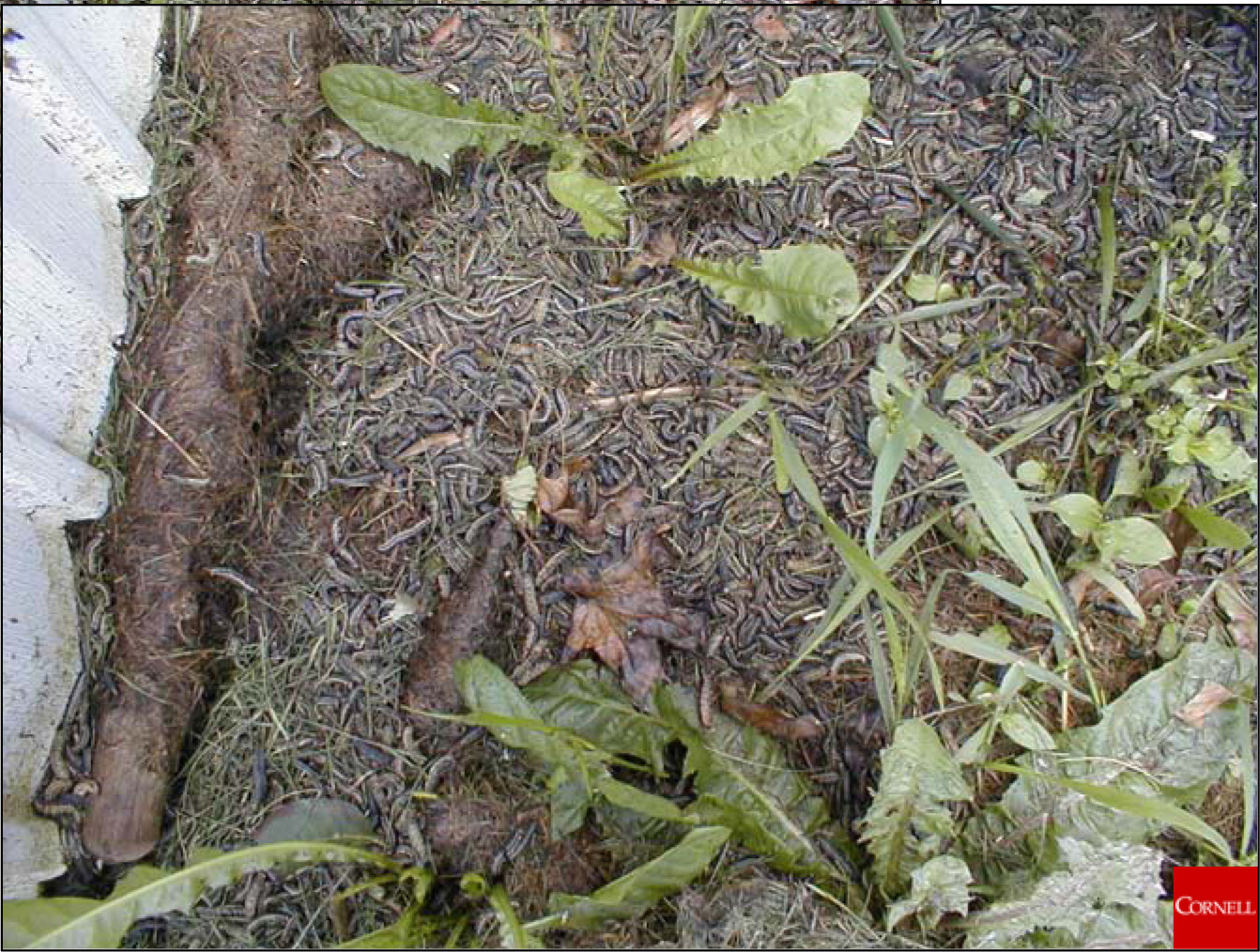 |
Impact of Environment on Population Dynamics:This insect is a long-ranged migrant which does not overwinter in NY. Adults (moths) arrive on the spring thunderstorms during May and June and are deposited in large numbers in localized areas where eggs are laid in a wide range of grasses including corn. Large numbers of eggs usually result in a large number of larvae which strip grass hay fields or corn fields and move in mass to new food sources. Hence the name of armyworm. This is only a one generation early summer pest because the eggs and the resulting larval generation is disperse in nature.
|
Impact of Environment on Crop Damage: None
|
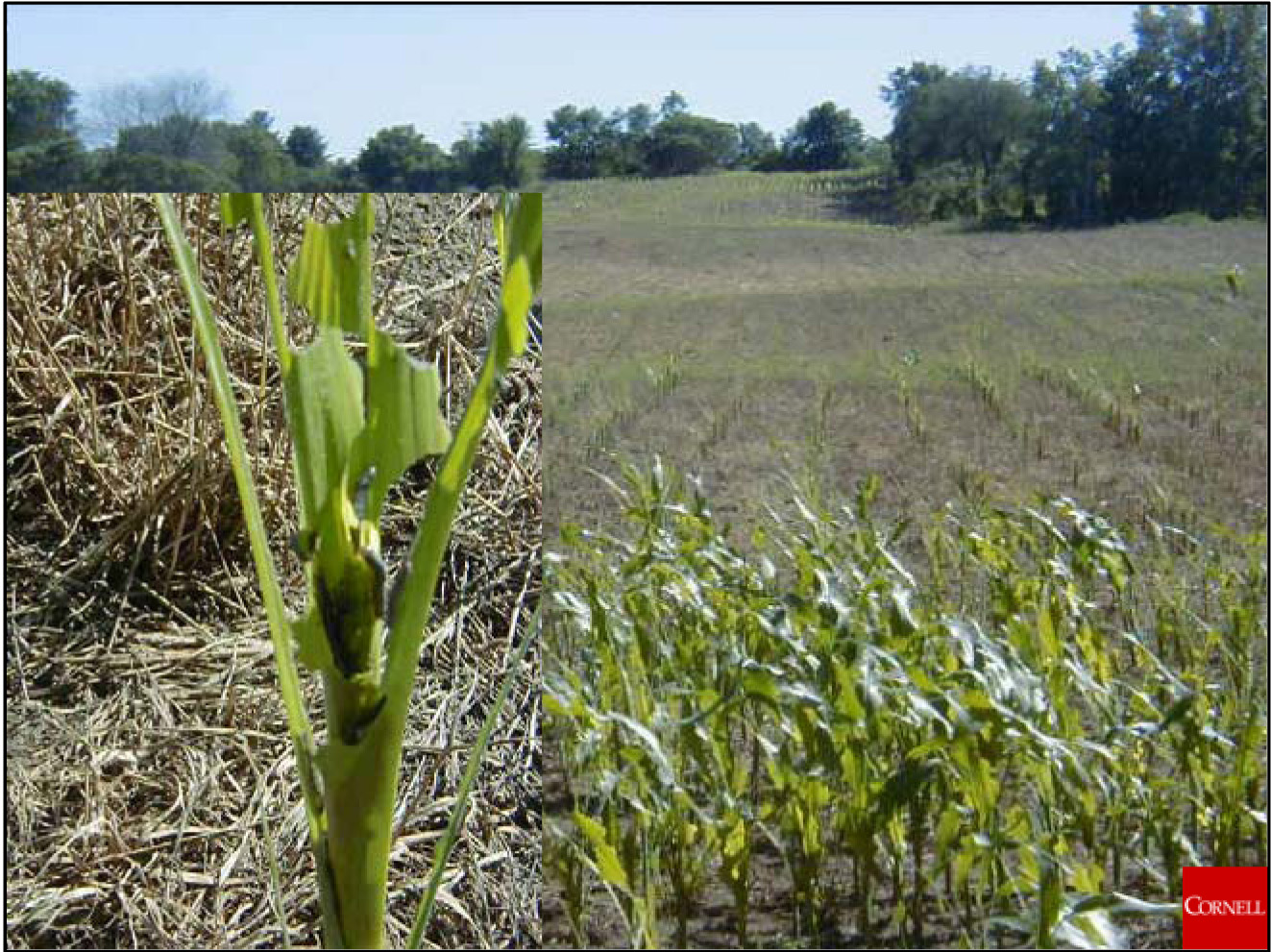 |
Management: Effective management of armyworm problems require early detection of the armyworm larval population before large larvae are present and the armyworms begin to march due to widespread defoliation of the primary field of infestation. Typically, armyworm infestations are only detected when large larvae are present and widespread defoliation is occurring. At this point, larval feed will only continue for an additional 7 days or so and by the time insecticide is applied, the economic losses have already occurred. The total economic loss then includes the loss of crop and the cost of the insecticide with application which has limited effectiveness. |
Black Cutworm |
|
Pest Type: Secondary |
|
Feeding Habit, Host Range, Injury Type, Symptom, Damaging Stage: |
|
Lifecycle: Black cutworm is a long-ranged migrant with the overwintering area in the southern states. Migrant moths invade the northern ranges in the spring aided by the fast moving southerly winds along storm fronts. Spring migrants typically arrive between mid-April and mid-May. The picture below is a radar image of migrating moths in the center of the picture and the clouds of a storm front along the left side of the picture.
The magnitude of the migration into New York and the Northern Eastern US variable and is dependent on population buildup in the southern states and the direction of the southern winds during the time of peak moth migration. In the late summer-early fall, newly emerged moths return to the southern states in a long-ranged migration utilizing the northern winds immediately following the passage of a weather low pressure front to aid their migration. Black cutworm does not overwinter successfully in the northern tier of states.
Newly arrived spring migrant moths lay their eggs in grass hay fields, grass waterways or weedy patches in last year’s corn fields. Eggs hatch in 7-10 days and the newly hatched larvae feed on the grassy plants. When the field is spring plowed for corn production, the small larvae continue to survive on the dying grass plants until the corn begins to emerge. The black cutworm larvae then move over to the young corn plants and begin feeding. The next chart shows the relationship between the development of black cutworm larvae and corn, both driven by temperature. It shows that if black cutworm eggs were laid on newly emerged corn plants, the corn would develop past V4 where corn is difficult to cut before black cutworm larvae would develop into the cutting larval stages (L4-L7). A more typical relationship between cutting larvae and plant stage is shown in the pictures with corn and larvae. The plant is V3 to V4 and the larvae is L6. According to the chart, the larvae would have been in the field as small larvae (L3-L4) when the corn plants emerged. These small larvae were surviving on dying grassy weeds when the field was plowed or killed with herbicide until the newly planted corn emerged.
During the first half of the black cutworm larval stages (instars 1-3), the larvae remain on the plant and feed on the leaf margins. This feeding damage looks very similar to feeding damage by armyworm. However, when the larvae molt into the fourth larval instar, the larvae leave the plant during the daylight hours and hide around the base of the plant. At this time, plant cutting begins and continues for the remainder of the larval instars (instars 4-7) (about 2 weeks depending on the temperature). |
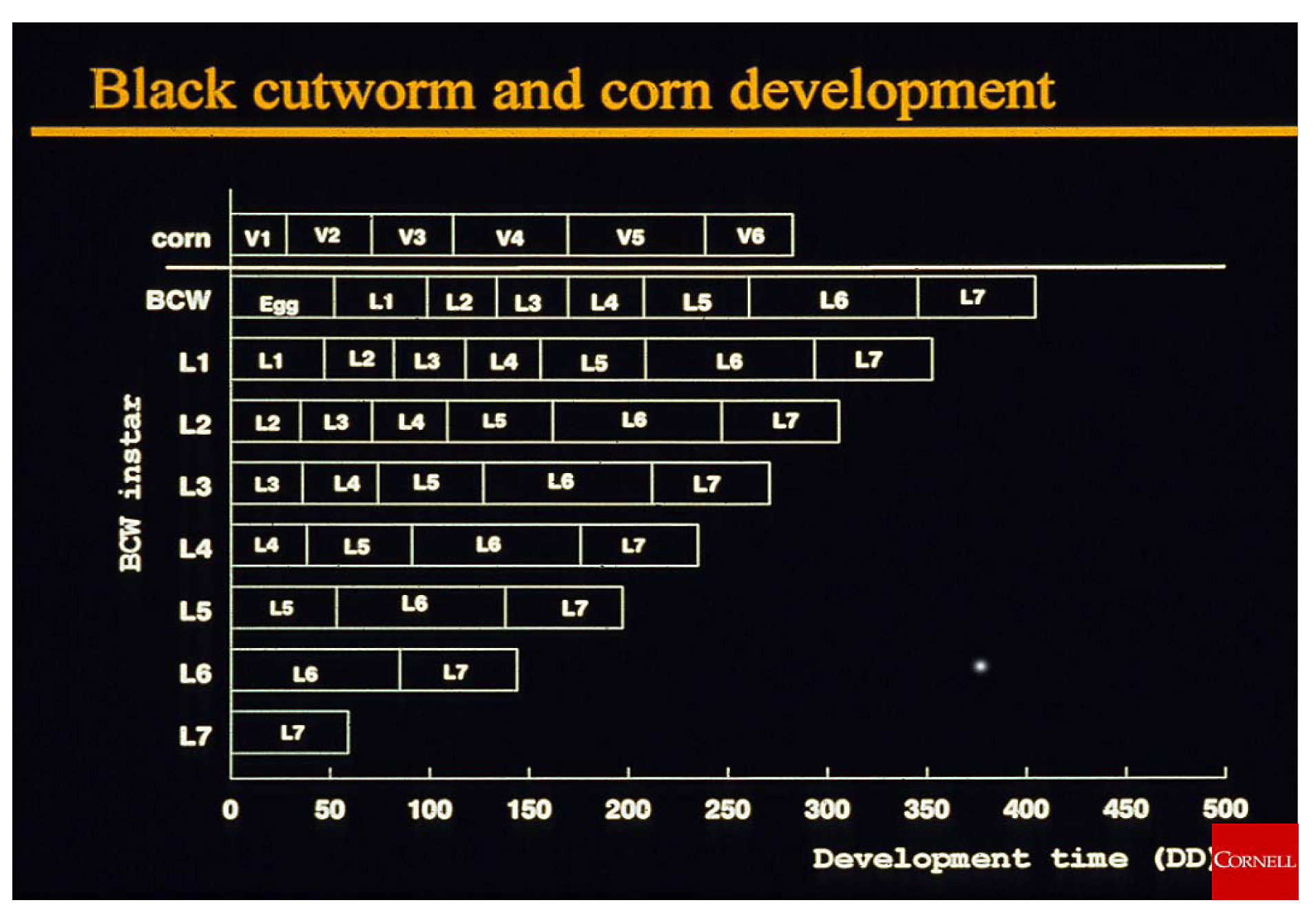 |
Impact of Environment on Population Dynamics and Crop Damage: Insect development is driven by temperature. Black cutworm being a spring pest, the temperatures during spring have a direct impact on the speed of both larval development and corn development.
Warm springs will have a shorter period of black cutworm damage than cooler springs. The severity of damage is directly related to the relationship of larval size (when the larvae begin to cut) and the growth stage of the surrounding corn. |
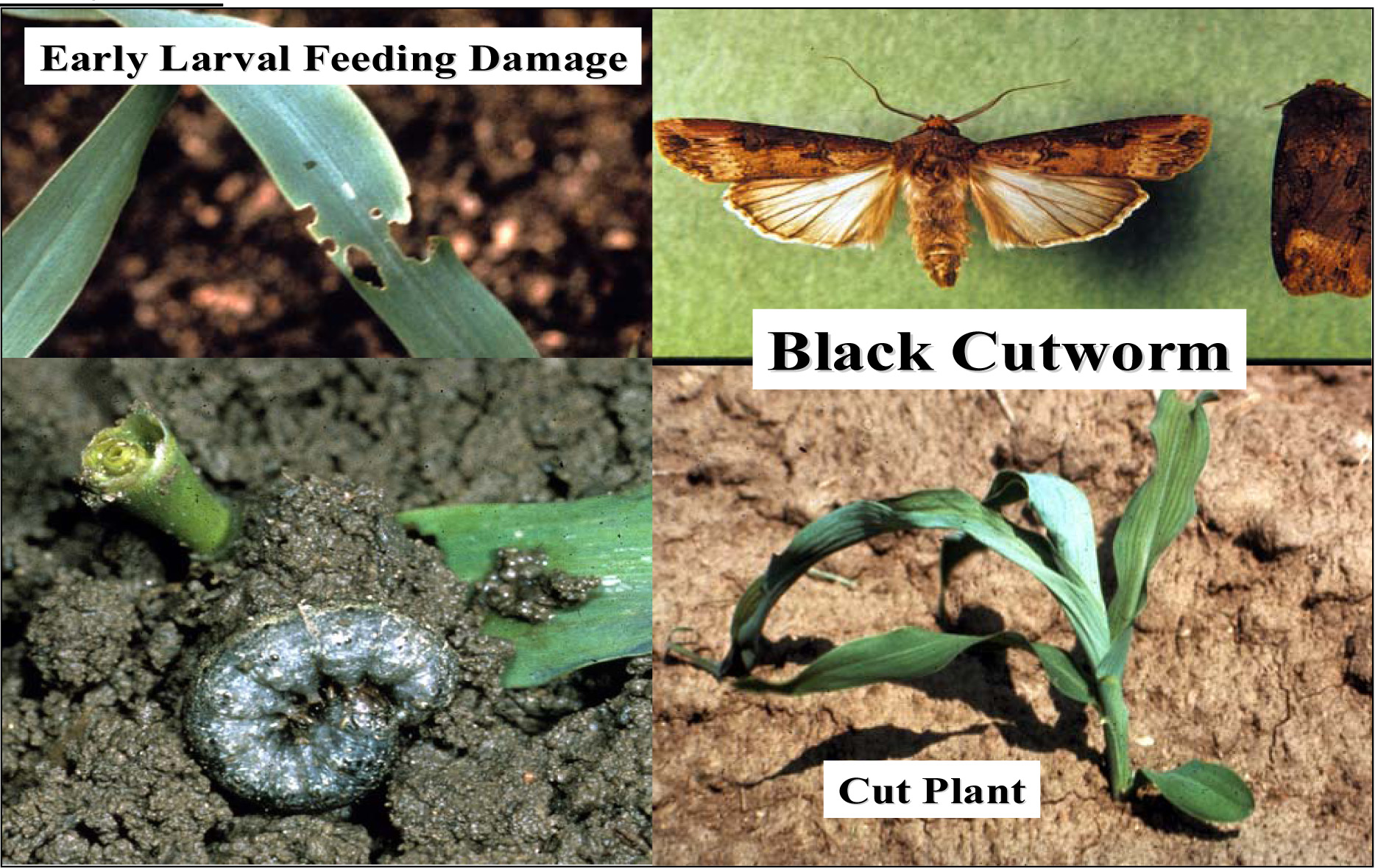 |
Management: Effective management requires the early detection of the smaller larval instars of the cutworm, before the larvae become large enough to begin cutting. Once cutting begins, economic losses can quickly accumulate from the damaged or killed plants. Corn has an ability to compensate for stand losses but the pattern of plant losses in important in the ability of the plant stand to compensate. If the stand losses are in patches, the surround plants are not able to completely compensate for the missing plants. In the situation of an occasional missing plant within a row, the adjacent plants have an excellent ability to compensate for the missing plant. Damaged plants pose a larger problem than missing plants since they continue to compete for sunlight, nutrients and moisture. Severely damaged plants are delayed in maturity sufficiently that maturity may not be completed by killing frost in the fall, causing economic yield and quality losses. |
White Grub |
|
Pest Type: Secondary |
|
Feeding Habit, Host Range, Injury Type, Symptom, Damaging Stage: There are many species of white grubs (June beetles) which are found in NY and the North Eastern US which feed on grass roots and can become a pest of both corn and grass pastures. The array of native white grubs have a 2-7 year lifecycle where the larvae feed underground for several years. In established grass fields, a wide array of larval sizes indicate that the white grub population is of the native species variety. In contrast, if all of the larval stages are very similar in size, it suggests that the white grub population is mainly comprised of the imported annual white grub species (Japanese Beetle, European Chafer). |
Annual White Grub Lifecycle: Adult beetles emerge in June (thus the name of June Beetle), mate and begin laying eggs during July in existing grassy environments. These areas range from lawns and grassy areas along roads to grassy hay fields. Eggs hatch in late July and the small larvae begin feeding on grass roots. Root feeding continues until fall when the cooling soil temperatures trigger the grubs to move deeper in the soil to below the frost line for overwintering. The larvae at this point are 0.5-0.75 grown. After passing the winter months deep in the soil, the larvae move back up to the top soil layers in the following spring to resume their feeding. It is the spring feeding by large larvae which cause the most significant feeding damage on the grass roots. Larval development is completed in late May to early June when the larvae pupate and the adult beetles emerge in mid-late June. |
Multi-year White Grub Lifecycle: The lifecycle of the multi-year white grub species is very similar but more protracted and less synchronized. Summer adult emergence and egg laying extends over a longer period and the larval stage requires multiple years to develop in the soil. |
Importance of Lifecycle on Crop Damage: Identification of the white grubs present in the field is important because the type of white grub present impacts the severity and longevity of the crop damage. For example, if the majority of the population of the white grubs is of the annual lifecycle variety, the damage will tend to be more severe but will usually be a single year event. In contrast, if a multi-year white grub dominates the population, the damage will tend to be less severe due to the lack of all larvae being at the most damaging stage at the same point in time but the problem will persist for a number years until the white grub population matures into adult and departs. Corn fields usually have a white grub problem when directly following a long term grassy sod. If the white grub population is of the annual variety, severe damage will occur to the corn roots when the plants are small in May-June but all feeding will disappear by late June. Second year corn in the same field will not have problems with white grub feeding. If the white grub population is the multiyear variety, root damage will occur to the corn for the entire growing season and second and third year corn in the same field will also suffer root feeding from white grubs but usually at a lower level. |
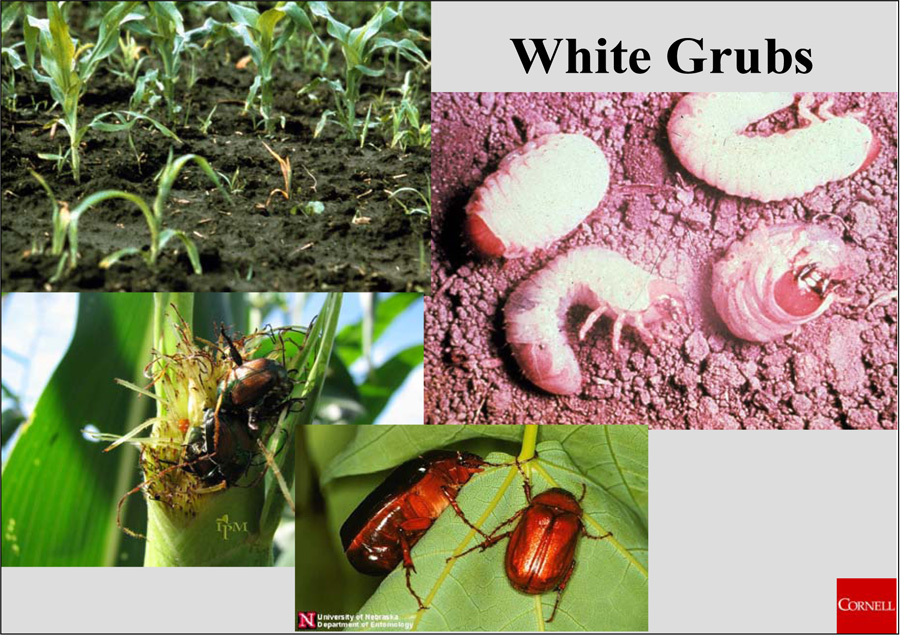 |
Impact of Environment on Population Dynamics: Since white grubs spend most of their life in the soil, severe problems usually occur in fields where good drainage is present. Field with down drainage seldom develop a significant white grub problem because the insects drown or suffocate when the soils become water-logged. |
Impact of Environment on Crop Damage: White grub feeding damage is the removal of roots from the plant, reducing the plant’s ability to uptake water and minerals. Therefore, crop damage from root feeding is more pronounced during times of drought and low levels of soil moisture. |
Management: Effective management of white grubs requires the anticipation of a grub problem before it occurs and the deployment of an effective insecticide to prevent damage to the crop. Rescue treatments are expensive and rarely effective. With the currently available technology of soil active seed treatments, the use of these seed treatments on a regular basis effectively minimizes damage in most cases except where the white grub pressure is extremely high. |
Wireworm |
|
Pest Type: Secondary |
|
Feeding Habit, Host Range, Injury Type, Symptom, Damaging Stage: |
|
Lifecycle: Wireworms are native to North America and there are a number of species present throughout NY and the NE US. These species have a multi-year lifecycle with the larvae living in the soil for more than one year developing on plant roots, primarily grass roots. The adults (click beetles) typically emerge in early summer to mate and lay eggs in grassy areas such as lawns, grassy hay fields and roadsides. These eggs hatch and larvae feed on primarily grass roots for 2-7 years depending on the species. Immature larvae move down in the soil profile in the fall, below the frost line to overwinter. As soils warm in the spring, these overwintering larvae move back into the plant root zone to resume feeding. Problems in corn are usually noted after rotating land into corn after long-term sod and wireworm problems are more prevalent in well drained fields compared to down-drainage fields. Wireworms can also become a problem in crops such as wheat which are grown in a non-rotational system. Since wireworms spend most of their life in the soil, severe problems usually occur in fields where good drainage is present. Field with down drainage seldom develop a significant white grub problem because the insects drown or suffocate when the soils become water-logged. |
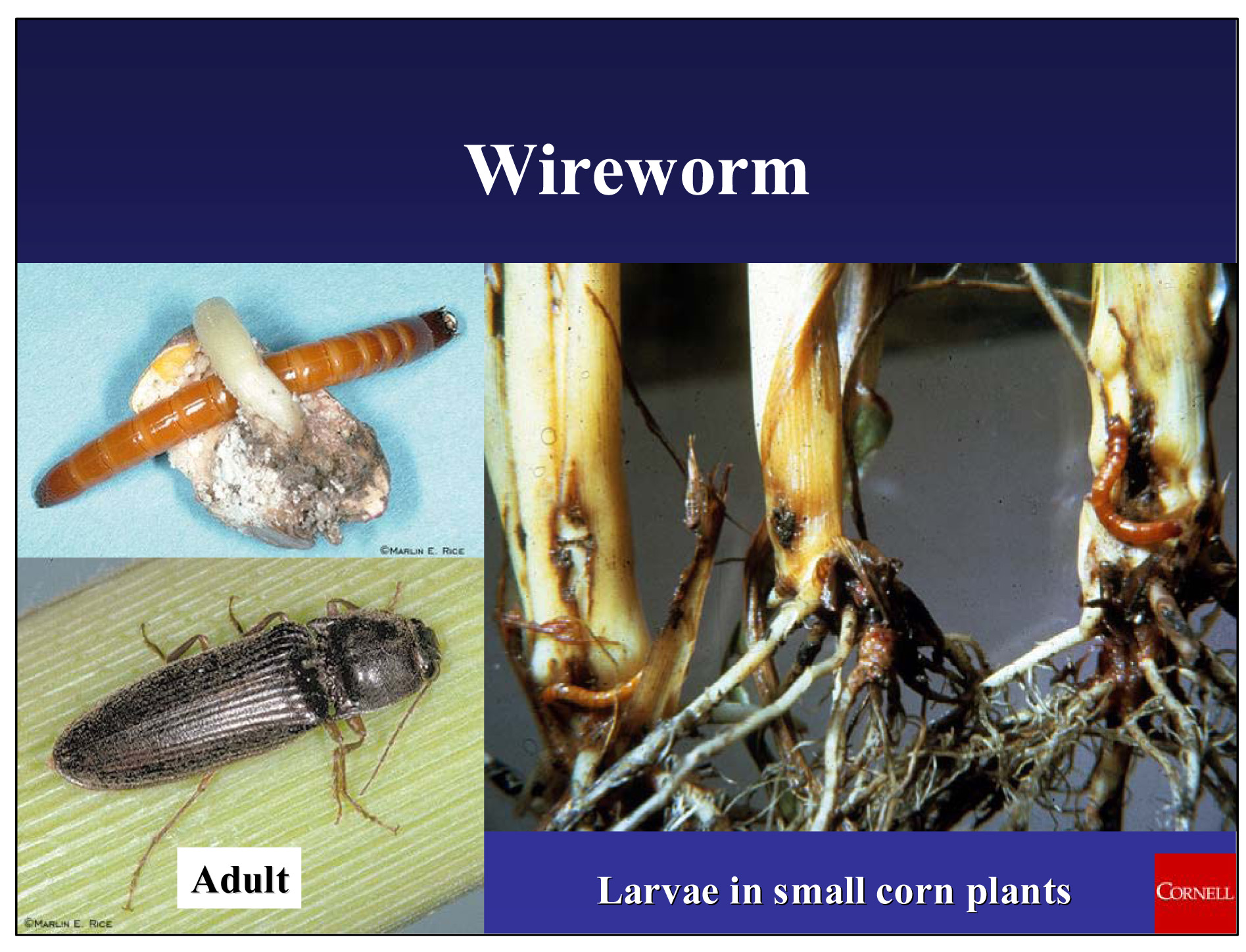 |
Impact of Environment on Crop Damage: Wireworm feeding damage is the removal of roots from the plant, reducing the plant’s ability to uptake water and minerals. Therefore, crop damage from root feeding is more pronounced during times of drought and low levels of soil moisture. |
Management: Effective management of wireworms requires the anticipation of a wireworm problem before it occurs and the deployment of an effective insecticide to prevent damage to the crop. Rescue treatments are expensive and rarely effective. With the currently available technology of soil active seed treatments, the use of these seed treatments on a regular basis effectively minimizes damage in most cases except where the wireworm pressure is extremely high. |
Corn Leaf Aphid:
Corn leaf aphid is not generally a problem on corn grown in NY or the NE US.
Grasshopper:
Grasshoppers are generally not an economic problem in agriculture in NY and the NE.
Fall Armyworm:
Fall armyworm is generally not a problem in NY and NE field crop production. It can be present and invade late season sweet corn. It is a long-range migrant similar to true armyworm except the moths tend to migrate northward in midsummer.
Slugs |
|
Pest Type: Secondary |
|
Feeding Habit, Host Range, Injury Type, Symptom, Damaging Stage: While slugs are not insects, being invertebrates they become the domain of entomologists. Slugs are related most closely to snails. They feed by rasping off leaf tissue with mouth parts. There are a number of slug species throughout the northern US and they feed on a wide range of plants. Slugs become an economic pest in fields with enough trash on the soil surface to provide hiding places during the daylight hours. In addition, populations increase during periods of high moisture and cloudy days. In corn fields, problems are usually noted during cool springs when the corn is small, large amounts of trash are left on the soil surface and weather conditions are cool and damp. In most cases, corn will grow out of slug damage when weather changes to the more typical warmer, dryer conditions. |
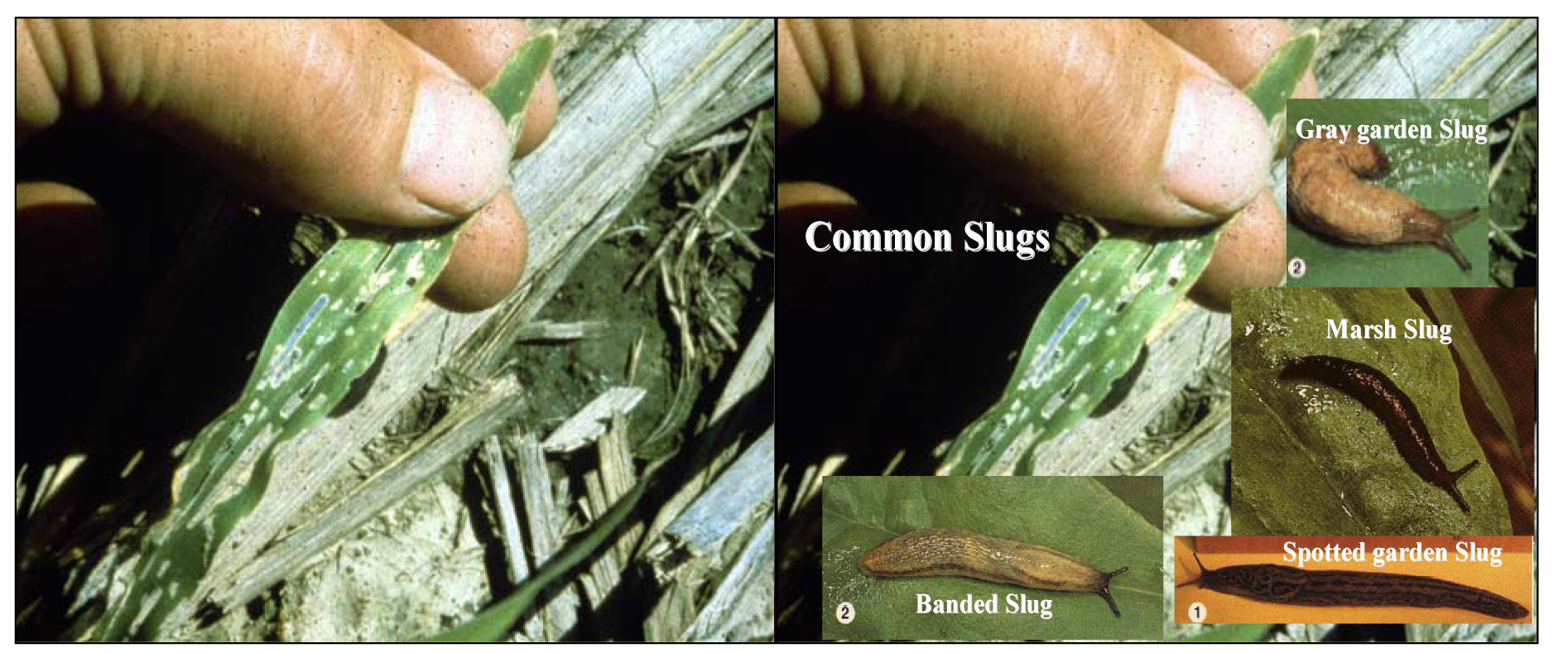 |
Management: There is no economically effective management tool for slug problems once they develop. In fields with chronic slug problems, soil management practices which minimize the amount of crop debris on the soil surface will minimize any slug problems in most springs. |
Seedcorn Maggot |
|
| Pest Type: Secondary |
|
Feeding Habit, Host Range, Injury Type, Symptom, Damaging Stage: Seed corn maggot is an introduced insect and a pest of seedlings. The larval feeding from this insect causes a reduction in plant stand. Although this insect attacks all germinating seeds and young plants, the impact is most significant on large seeded crops such as corn, soybeans and beans of all types. This insect has multiple generations per year but is only economically important in agriculture during the months of May and June when crops are being planted and germinating. |
Lifecycle: Adult seed corn maggots (flies) emerge in late April-early June from overwintering puparia in the soil. After mating, the female flies fly close to the surface and lay eggs in areas of decaying organic matter, dying plants and/or germinating seedlings. After hatching, the larvae feed on the organic matter, plant seedlings and germinating seeds. Damage to agricultural crops is expressed as skips in the plant stand where seedlings were killed before emerging and damaged seedlings which may die after emergence.
Damaged emerged corn seedlings typically have numerous holes in the leaves after the leaves have unrolled. Damaged soybean seedlings (and other beans) typically have just the stem with no leaves (snake heads). These headless stems die after emergence due to the destruction of the growing point. After maturing, the larvae pupate in the soil and emerge as flies to continue the next generation. This insect has multiple generations per year but is only economically important in agriculture during the months of May and June when crops are being planted and germinating. |
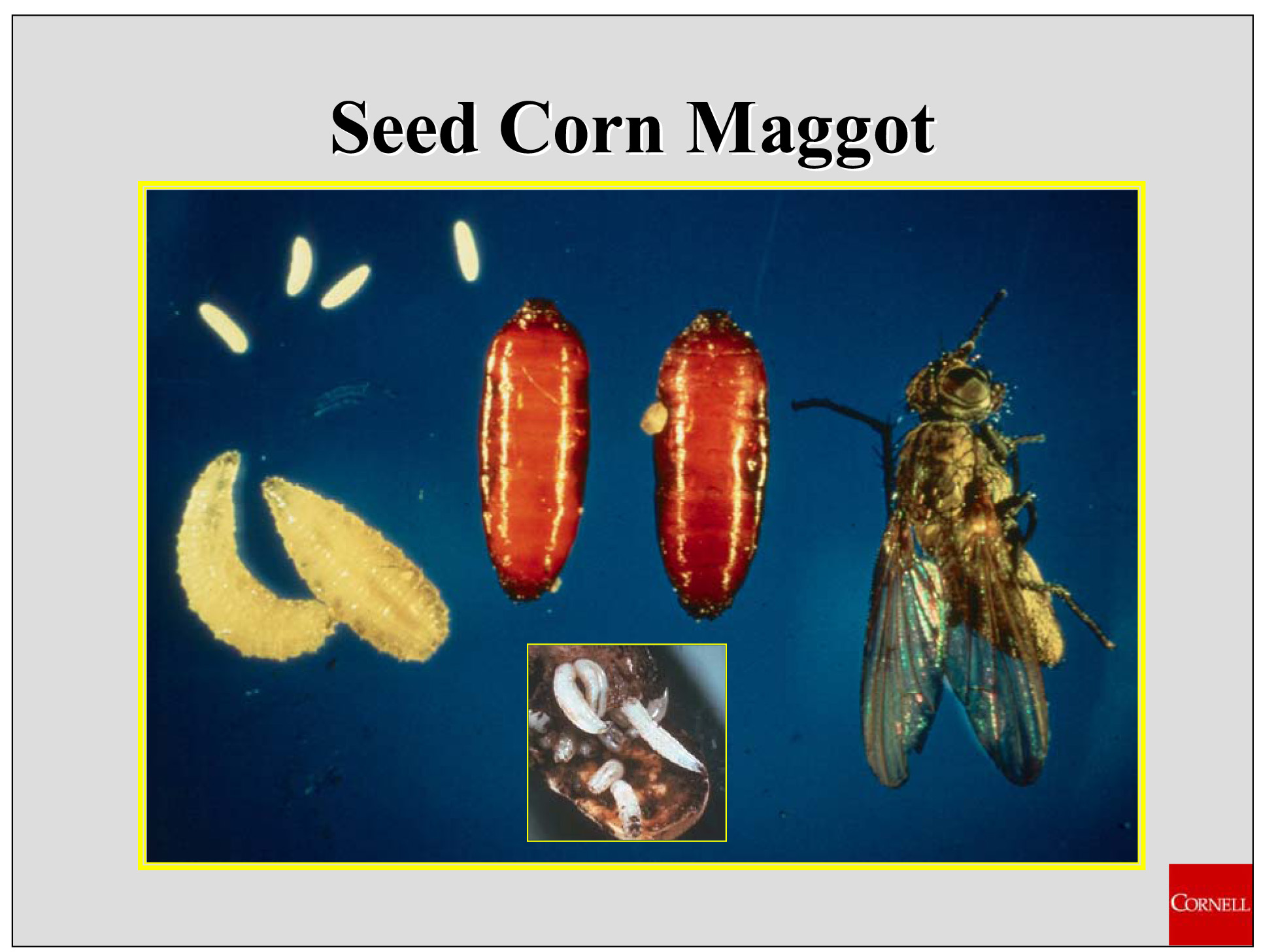 |
Impact of Environment on Population Dynamics: Insect development is driven by temperature. Seed corn maggot being a spring pest, the temperatures during spring have a direct impact on the speed of both larval development and crop development.
Warm springs will have a shorter period of seed corn maggot damage than cooler springs. |
Impact of Environment on Crop Damage: Cool springs which delay the emergence of seedlings increase the window of potential risk and damage to this insect. The longer the seedling takes to emerge, the greater chance that the seedling will be damaged by seed corn maggot. Risk is increased when planting in fields with high organic content or after recently plowed crops such as alfalfa or grass hay. A typical example of a high risk field is the field closest to the barn which receives a large dose of manure. During mid season, the missing corn plants from seed corn maggot attack in these fields can be spotted at highway speeds. |
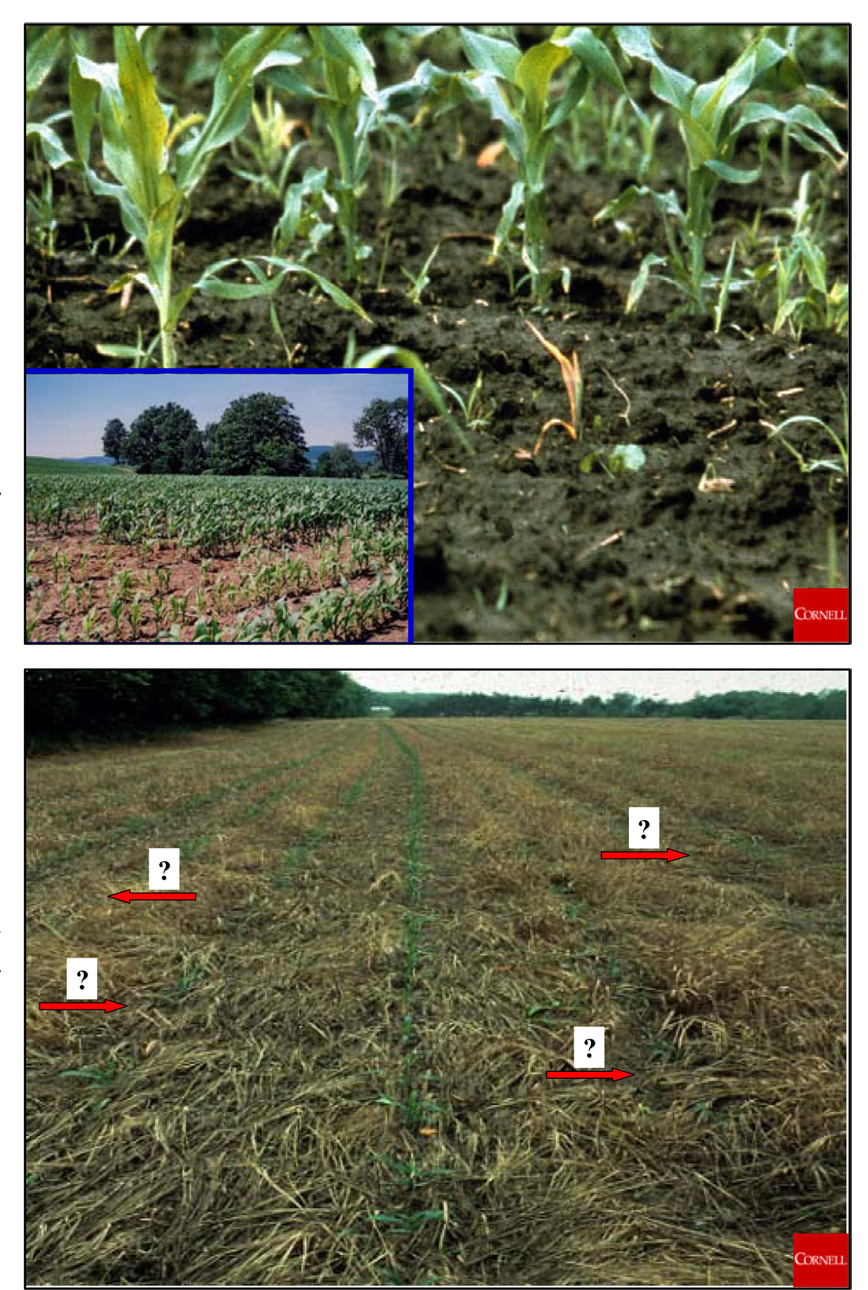 |
Management: Seed corn maggot problems are difficult to anticipate and therefore all large seeded crop seeds need to be treated with a seed treatment insecticide to prevent stand losses from this insect. In corn, almost all available commercial corn seed is treated with the low rate of soil active seed applied soil insecticide which is applied for the control of seed corn maggot and other secondary pests like wireworm. |
ARTHROPODS OF SMALL GRAINS
Cereal Leaf beetle |
|
Pest Type: Primary |
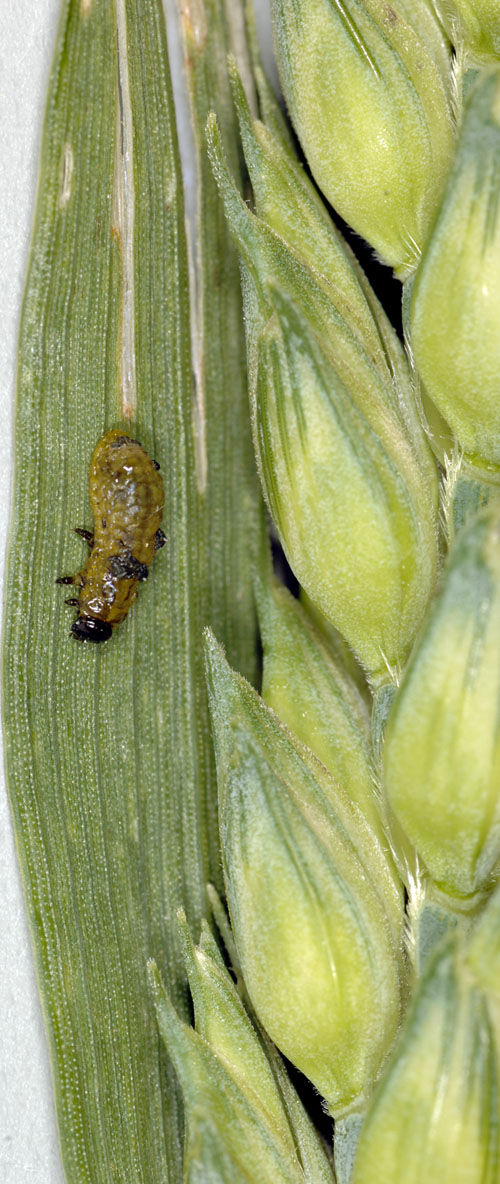 |
Feeding Habit, Host Range, Injury Type, Symptom, Damaging Stage: |
Lifecycle: Cereal leaf beetle is a pest of small grains. The adults overwinter in the field edges and enter the fields in the spring. Eggs are laid on the leaves of the small grain plants. The larvae which hatch from these
eggs defoliate the plant and it is the defoliation which causes any yield losses. In most years, the
introduced biological control agents hold the cereal leaf beetle populations at sub-economic levels.
However, each year there localized fields reported where the cereal leaf beetle population reaches
levels where the application of an insecticide may be justified to reduce the economic impact of the
insect. |
Management: In most years and in most fields, the established biocontrol agents prevent the cereal leaf beetle
populations from increasing to economically damaging levels. Occasionally, localized populations can
exceed these levels and the application of an insecticide may be justified. However, caution should be
used because insecticides effective on cereal leaf beetle also have a negative impact on the biological
control agents. |
Wireworm:
See discussion above in arthropods of corn
ARTHROPODS OF SOYBEANS
Soybean Aphid |
|
Pest Type: Primary |
|
Feeding Habit, Host Range, Injury Type, Symptom, Damaging Stage: Soybean aphid is a recently introduced pest from the far eastern parts of the world. In some years, populations can rise to economic levels and in other years, the populations remain sub-economic.
Typically in NY, aphid populations are found in localized hot spots within fields and in localized fields within an area. Widespread infestations across a large number of fields within a region are seldom observed. |
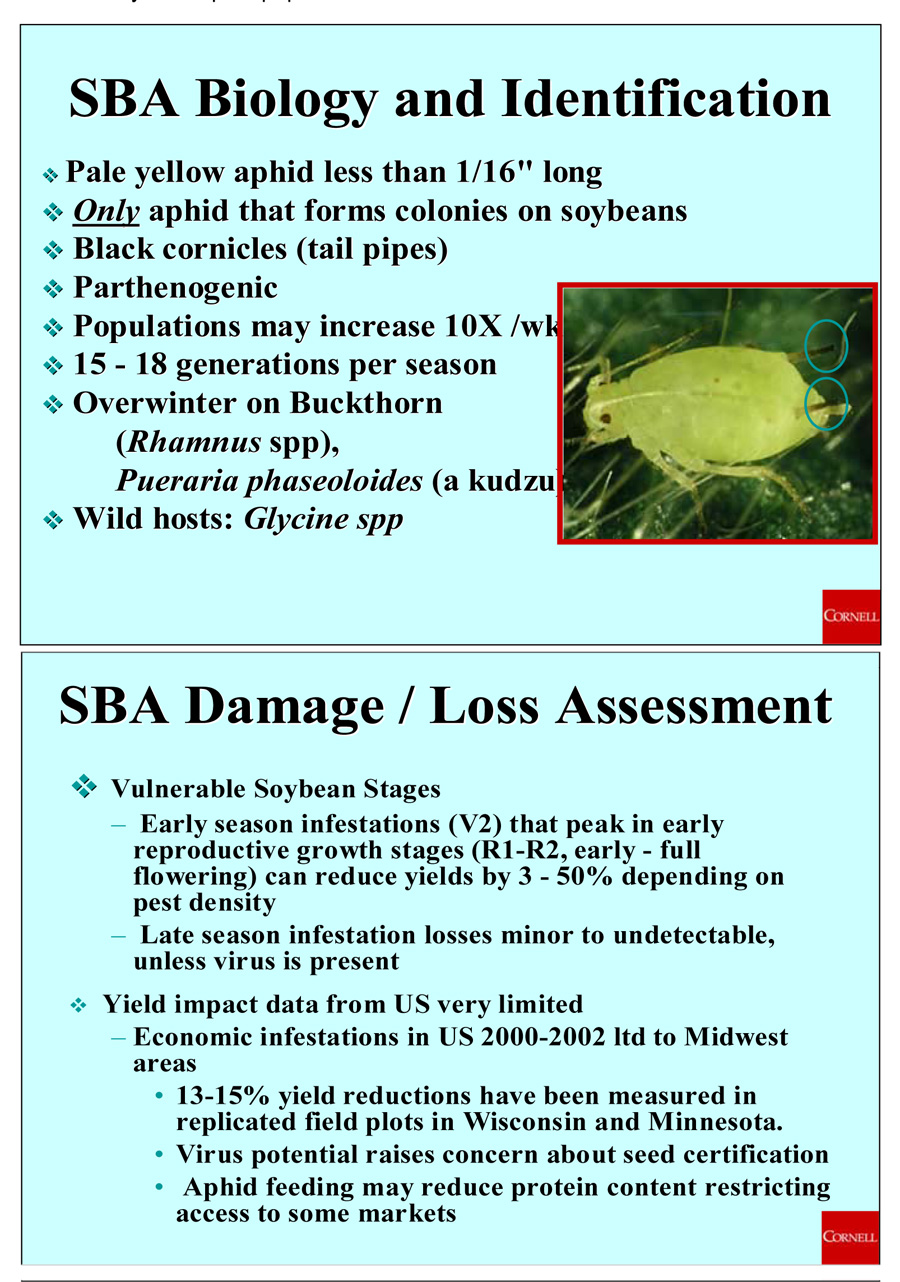 |
Lifecycle: Soybean aphids overwinter on buckthorn located on field edges and on the edges of forested tracts. In the spring, overwintering eggs hatch and the first generation of aphids develop on the overwintering host. After maturity, the winged aphids leave the buckthorn and migrate into surrounding soybean fields. This first migration event is usually during mid-late May. This is local movement from local overwintering hosts and is usually a small magnitude event. A second flush of aphids usually arrive in late June-early July in correlation with summer thunderstorm activity. These aphids are long-range migrants, usually from the upper Midwestern states and can be deposited in large numbers within a localized area. In most years, economically important aphid populations in individual fields are a result of these long-ranged migration events. Once a field is infested with the migratory winged aphids, wingless aphids are produced and the population cycles every 7-10 days, until very large numbers cause the decline of the plant quality. At this point, winged aphids are produced and the winged aphids move to other plants. In late August-early September, winged aphids are produced and these aphids leave the soybean fields and fly to the overwintering host and lay eggs. These eggs then overwinter and initiate the next year’s aphid population.
In many years, biological control agents are effective in reducing the aphid population so it remains at sub-economic levels. These biological control pressures include predation by lady bugs, lacewing larvae and widespread epidemics of the entomopathogenic fungi.
|
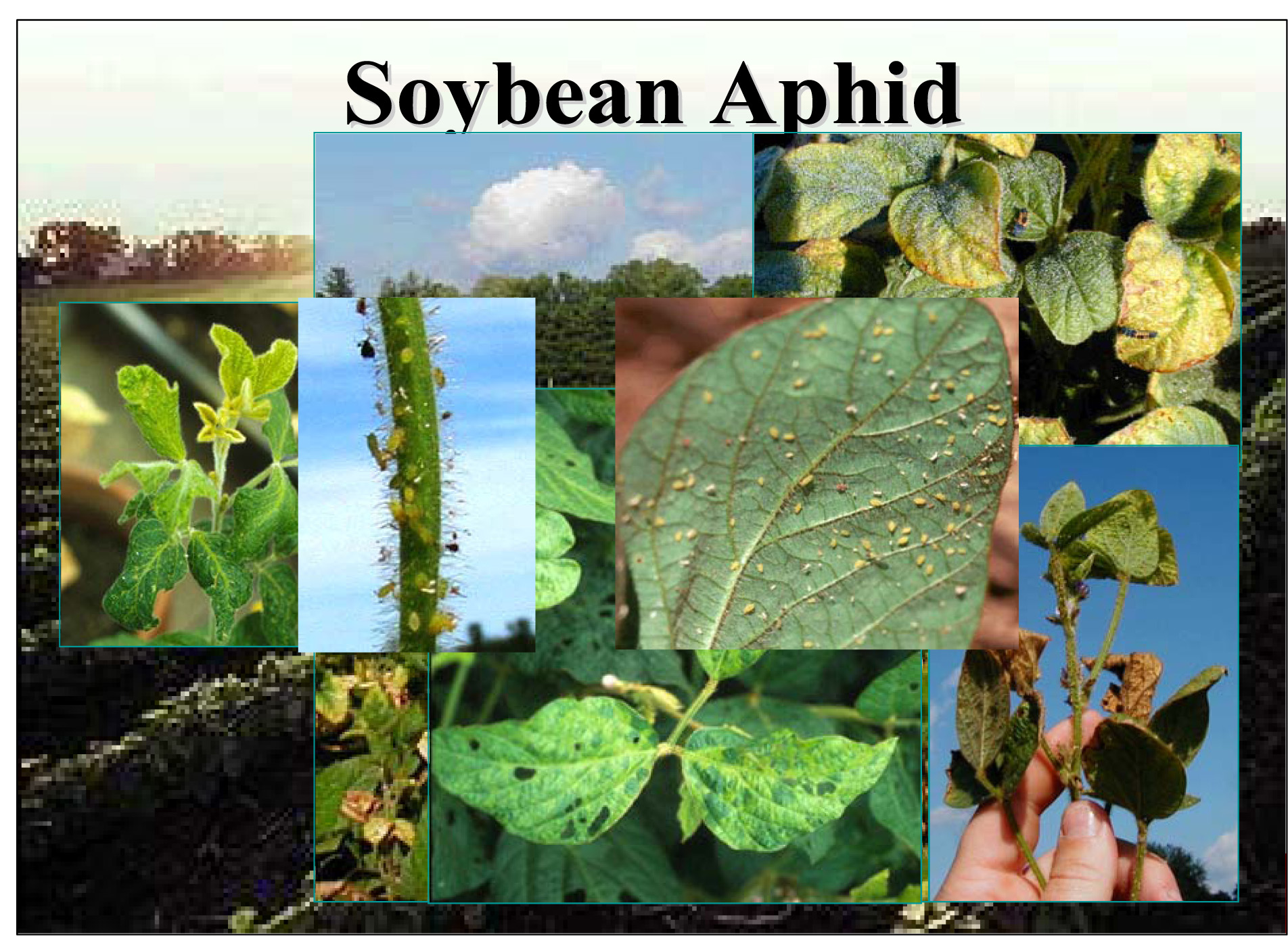
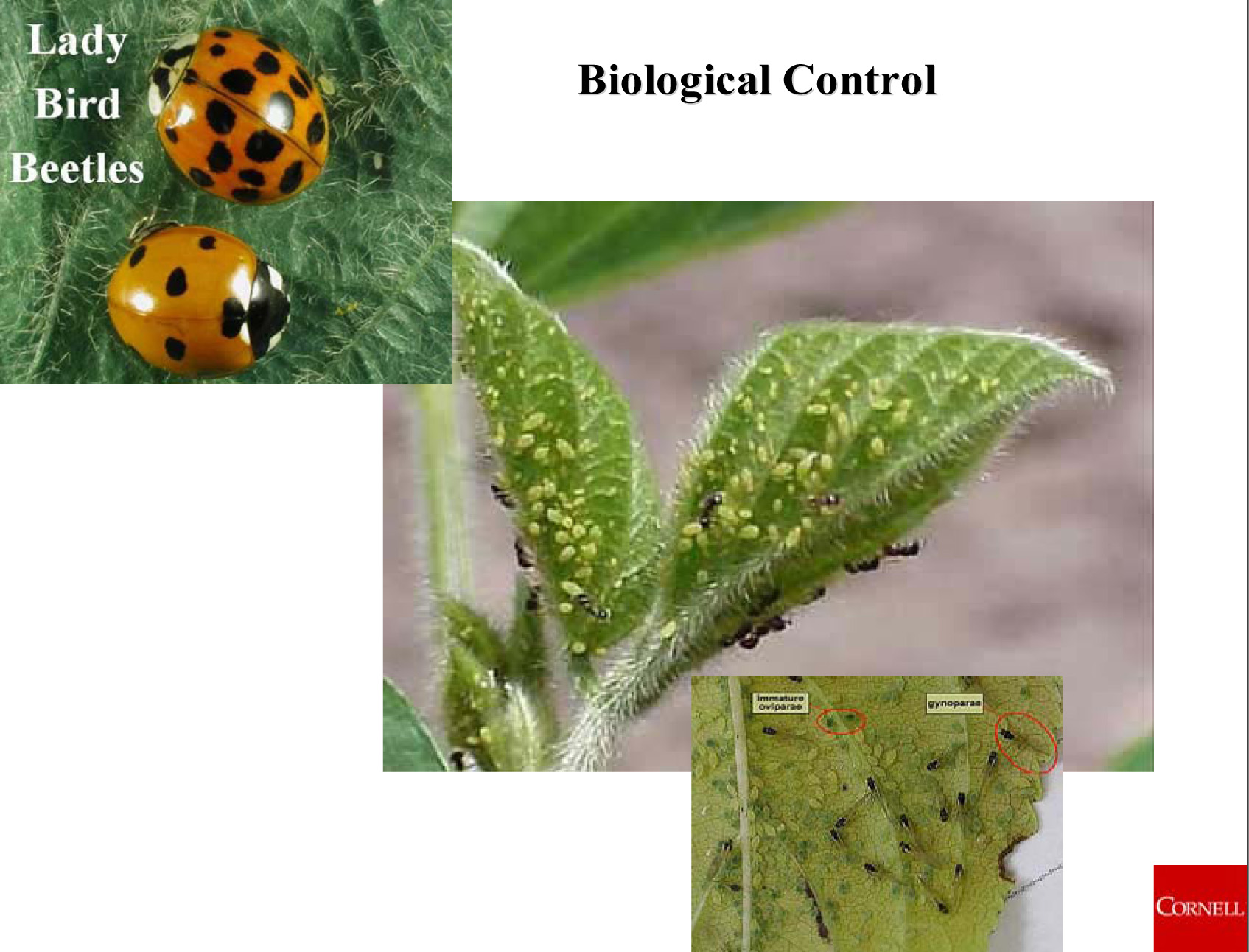
|
Impact of Environment on Population Dynamics:
Aphids are very sensitive to local environmental conditions. Hard rain storms wash the aphids off the plant and reduce the populations. Humid conditions encourage the outbreak of entomopathogenic fungi epidemics which quickly move through the aphid population and dramatically reduce the population. Dry periods encourage the predation by insect predators such as lady bugs. |
Impact of Environment on Crop Damage: Aphid feed removes plant fluids from the plant in significant quantities. During periods of low rain fall and droughty conditions, plant infested with aphids suffer water stress quicker than non-infested plants. The presence of long term or frequent water stress has a negative impact on plant yield. |
Management: Scouting fields for aphid economic numbers is an important step before any spraying. Early spraying for sub-economic populations of soybean aphids kill off the effective biological control insect predators and allow the surviving aphids to rebound quickly. In addition, these early treatments with insecticide often trigger spider mite outbreaks in hot dry years. Controlling spider mites is a difficult tasks and the yield losses from a widespread spider mite infestation is often greater than yield losses from aphids.
This scenario can be avoided by first scouting the field and only treating when the populations exceed economic levels and the plant is approaching the plant stages where aphid feeding has been documented to reduce yields. |
Spider Mites
Spider mites are not generally a problem on field crops grown in NY or the NE US. In soybeans, early insecticide applications for soybean aphid, coupled with hot dry summer conditions have been responsible for localized spider mite outbreaks. If insecticide applications are delayed until actual economically important populations of soybean aphid, spider mite infestations seldom occur regardless of the summer conditions.
Seed Corn Maggot
See discussion above in arthropods of corn
ARTHROPODS OF ALFALFA
Alfalfa Snout Beetle |
|
Pest Type: Primary |
|
Feeding Habit, Host Range, Injury Type, Symptom, Damaging Stage: |
|
Lifecycle: This insect has a 2-year lifecycle with most of its lifecycle spend in the soil. All development occurs during the first year and the insect remains deep in the soil in hibernation for the second year before emerging the third spring. Offspring from odd-year emerging adults will emerge as adults the following odd year (2007 2009). Adult: All adults are females and there are no known males in the North American population. Adults emerge from deep in the soil during the first week of May and feed on the foliage of a wide array of plants. Host plants include alfalfa, clover, rhubarb, grapes and roses. After about 3 weeks of feeding, the adults begin to lay eggs around the base of host plants. Economically, the most important plants are alfalfa and clover. Oviposition continues for about 4-6 weeks with each female laying between 150-300 eggs.
Larvae: The major economic damage to alfalfa and clover is caused by larval feeding on the roots of the plant. Small larvae feed on the secondary roots causing root pruning and reduction of the root system. As the larvae grow larger, they move to the main tap root where they girdle the tap root with longitudinal spiral feeding. As the larvae enter the last two larval instars, they sever the tap root and often feed up into the interior of the tap root. Larval feeding starts in early June with the feeding on the secondary roots and the larger larvae finish their feeding with sever root damage in the fall during October and November. Plant death from root feeding damage started in late summer and continues throughout the winter. Farmers are greeted in the spring with large areas of their alfalfa fields dead and devoid of plants (pure stands) or in mixed stands with grass, a hay field composed completely of grass without alfalfa.
|
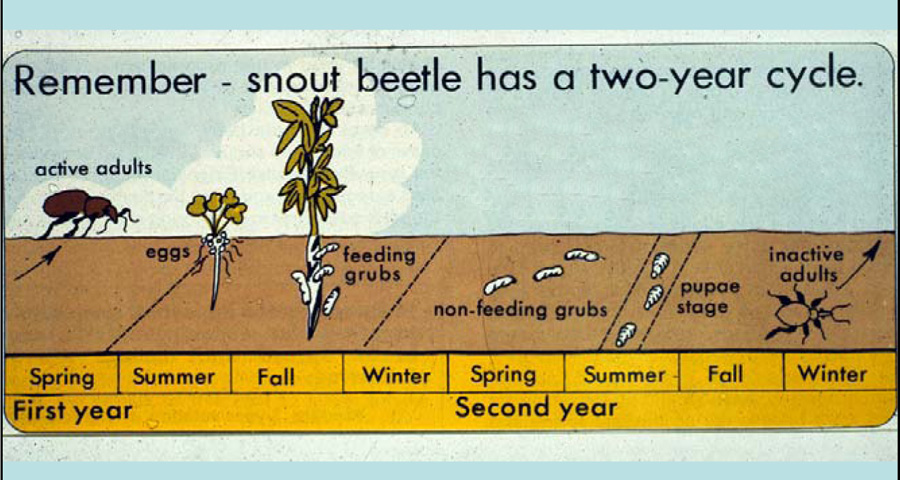
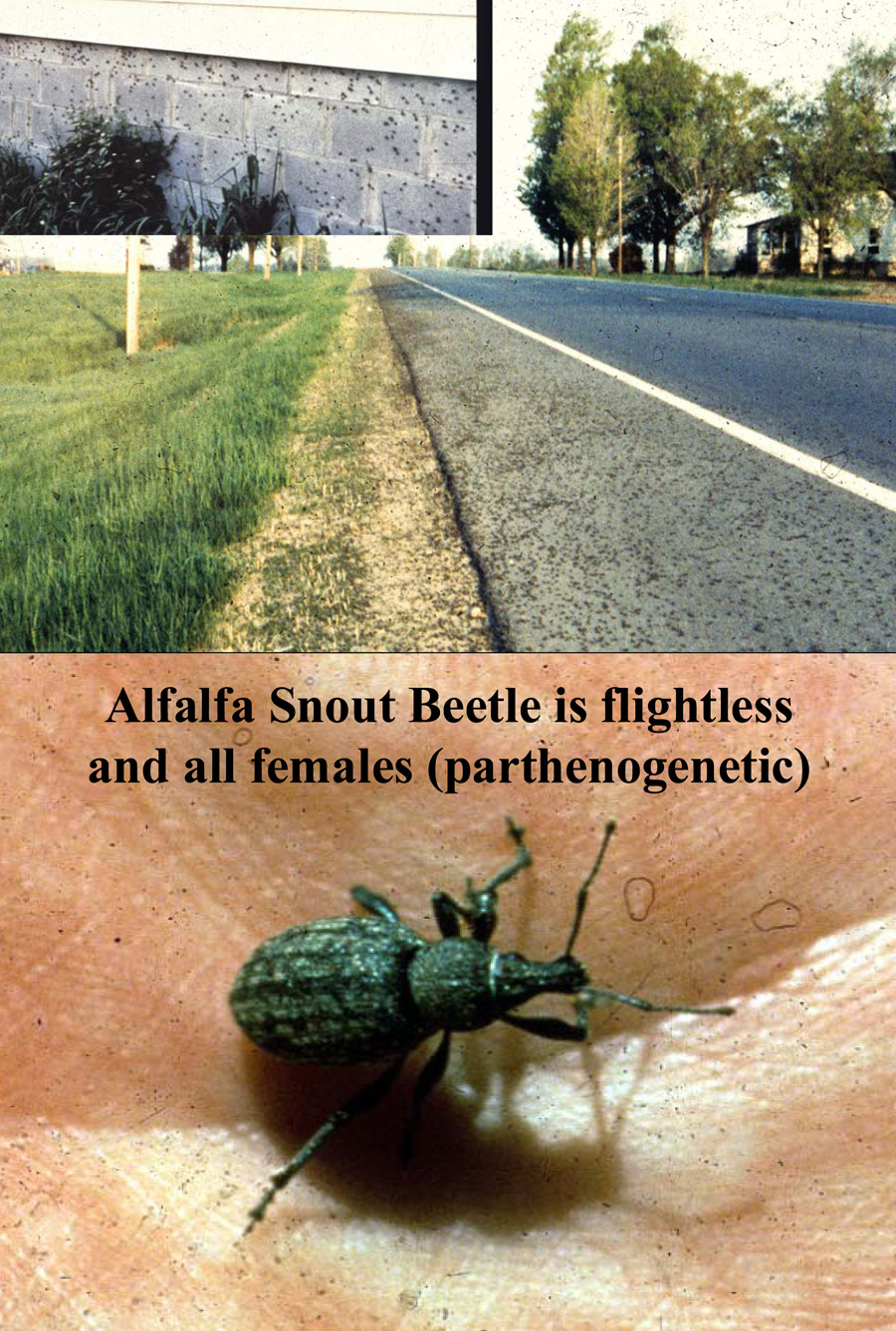
|
Impact of Environment on Population Dynamics: Since all of the extended larval stage is spent in the soil, the larval stages have difficulty surviving in fields with high water tables and poor drainage. This insect survives best in fields with excellent drainage (natural or tiled) and will build to very high populations under these conditions. In fields with poor drainage, this insect is not the leading cause of death of alfalfa stands. |
 |
Impact of Environment on Crop Damage: Dry soil periods during the periods of heavy root feeding increase the occurrence of plant death under droughty soil conditions. Plants surviving insect attack the previous year will often die the following year from water stress due to the severely pruned root system. |
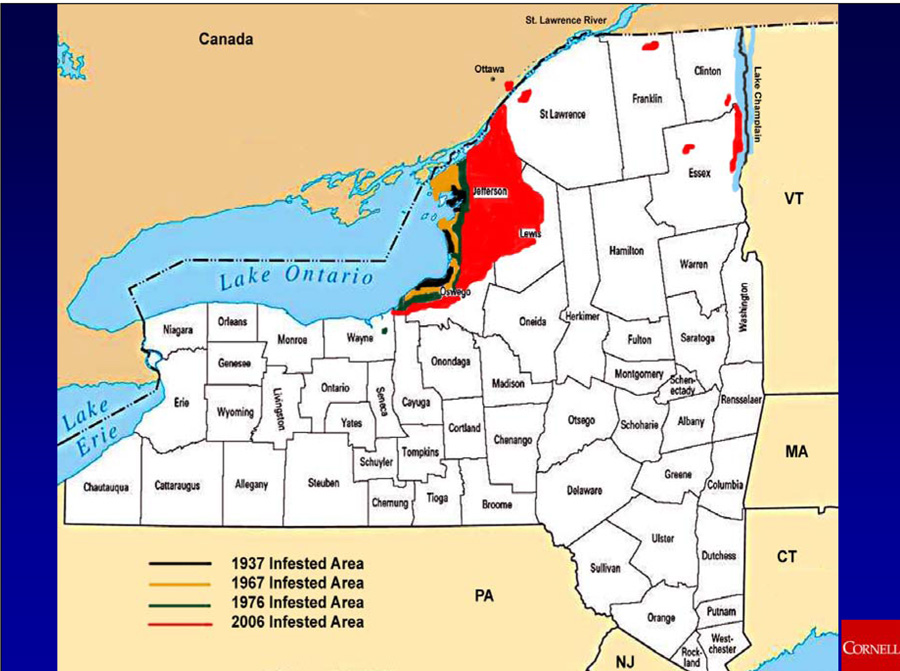 |
Management: There are currently no effective management strategies for alfalfa snout beetle. For the past decade, intense research efforts have been focused on the biological control of this insect with persistent entomopathogenic nematodes and the development of resistant alfalfa varieties. Field studies are currently being conducted focused on the effectiveness of these two strategies. |
Alfalfa Weevil |
|
Pest Type: Primary in first harvest (cutting). |
|
Feeding Habit, Host Range, Injury Type, Symptom, Damaging Stage: |
|
Lifecycle: Adults overwinter in the field edges and other protected locations until the warming temperatures of early to mid April. Adults then enter the field and begin feeding on the new emerging alfalfa foliage. After a period of feeding, the females begin laying eggs in a cavity chewed in the stems of the alfalfa plant. Upon hatching, the young larvae move to the growing tip of the plant where they develop on the leaves around the growing point. As weevil larvae increase in size, their leaf consumption rate increases to the point where 80% of leaf loss occurs during the final larval stage. With moderate to high populations, the field can turn brown from this late larval feeding in a few days. This is usually called “frosting”. INSERT PO27-alfalfaweevilfeeding.jpg
Upon completion of the larval stage, the larvae pupate in cocoons on the plant and then emerge as adults. The adults then leave the field for a summer hibernation until fall when the reenter the fields for feeding prior to overwintering. There is one generation of insects per year and the majority of the damage is limited to the first harvest of alfalfa.
The release of effective biological control agents in North America has reduced this insect to secondary pest status. A few localized hot spots are reported each year, but the biological control agents usually respond and insecticide applications are usually unwarranted. Often an early harvest of the alfalfa prevents an economic loss from this insect. Alfalfa stands with less than 50% are not economic to treat with an insecticide.
Cool wet springs are favorable to pathogenic fungi outbreaks which hold the insect in check. In addition, alfalfa has a lower temperature threshold for development than alfalfa weevil and the crop will usually be ready for harvest before alfalfa weevil reaches the economically damaging late larval instar. In these cases, early harvest is the best solution to prevent economic losses. In years when the spring conditions are warm and dry, alfalfa weevil can be an economically important pest in localized situations. |
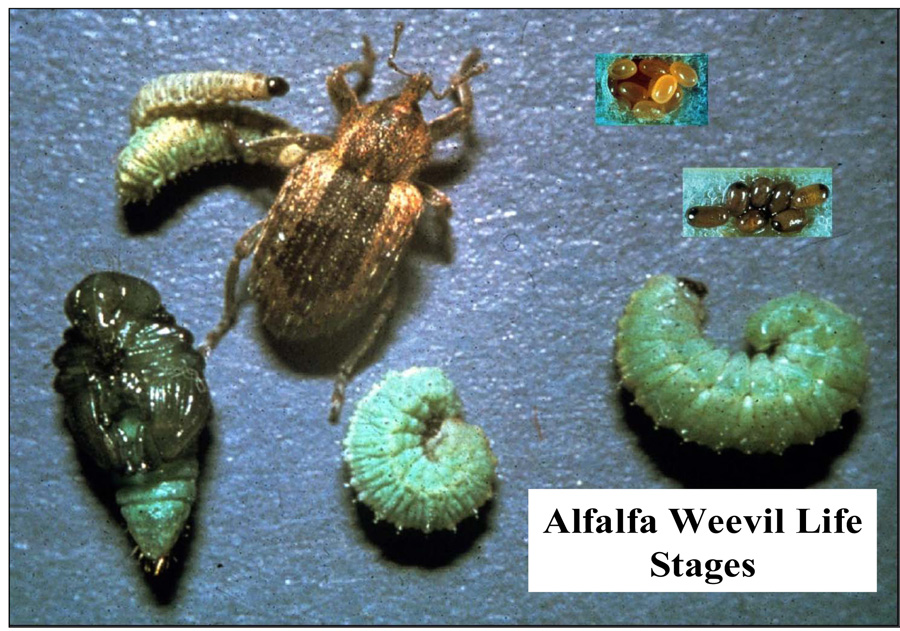
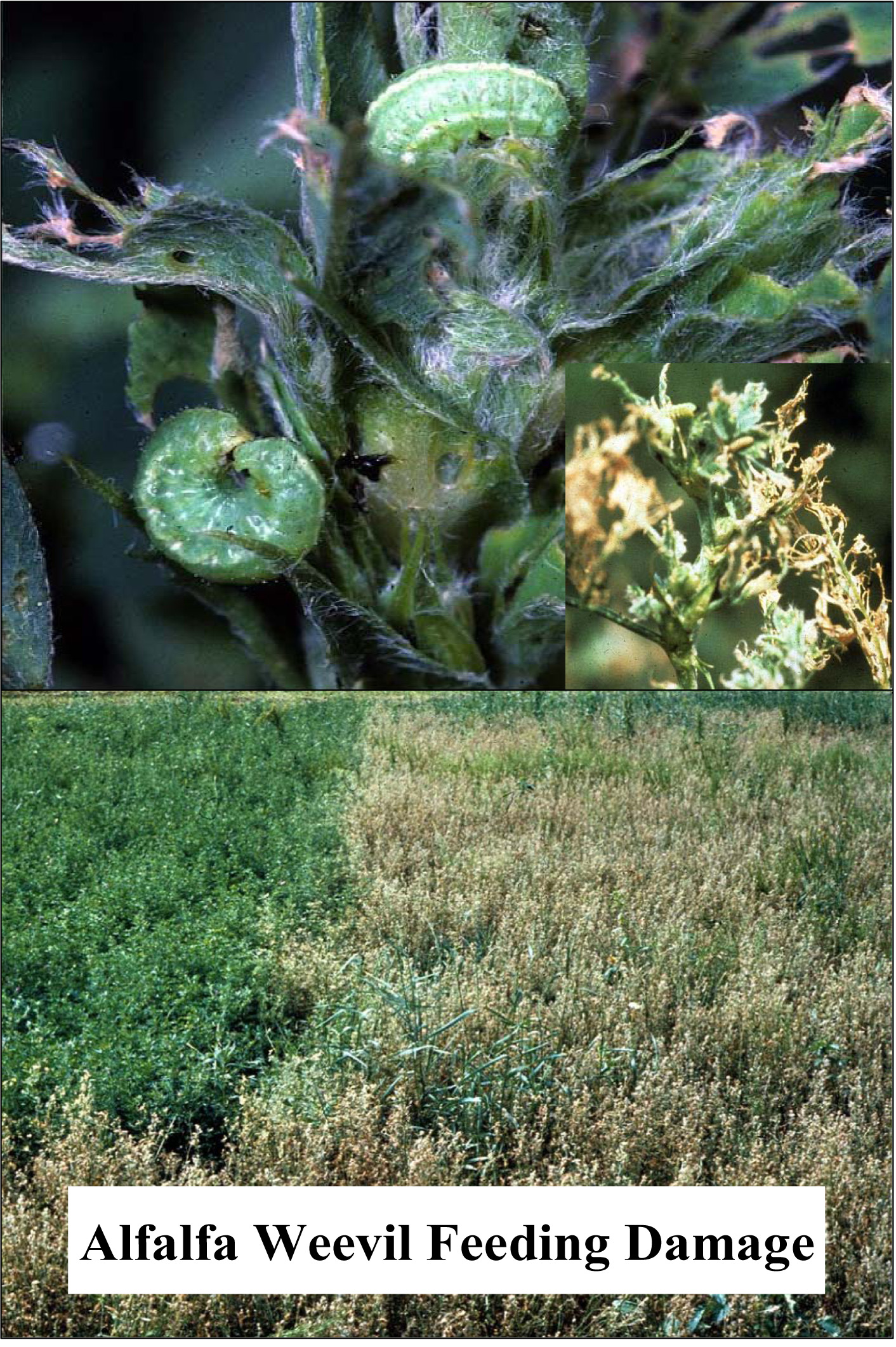
|
Management: In most areas and in most springs, the current array of biological control organisms prevents this insect from resuming its past role as a major insect pest of alfalfa. Each year, reports of localized outbreaks surface but early harvest of the crop usually prevents the economic loss from this insect. In subsequent years, the biological control agents re-exert their pressure on the population and the alfalfa weevil returns to its sub-economic level. If necessary, effective insecticides are available for alfalfa weevil larval control. |
Alfalfa Blotch Leafminer:
Alfalfa Blotch Leafminer is not an economic pest of alfalfa. This insect is being held at sub-economic levels by biological control which was accidentally introduced shortly after the insect was introduced into North America. It has never exploded into an economic pest since it was first introduced.
Pea Aphid:
Pea aphid, though often numerous in alfalfa fields, is seldom an economic pests. The cutting cycle of alfalfa reduces the population on a regular basis and the population does not have time to rebound to economic levels before the next alfalfa harvest.
Clover Root Curculio |
|
Pest Type: Secondary |
|
Feeding Habit, Host Range, Injury Type, Symptom, Damaging Stage: While the adults feed on the foliage, the economic damage from this insect is the larval feeding on the plant root system. The larvae chew grooves in the roots which may girdle the roots. In addition, the larval feeding wounds provide entrance for soil pathogens to enter the root. Most plant death is from the attack by soil pathogens. The major impact of this insect is a loss of plants in the alfalfa stand and the reduction of alfalfa stand life. |
Lifecycle: The adult beetles overwinter in the field edges and in close by wooded areas. In the early spring, the overwinter adults break diapauses (hibernation) and enter the alfalfa or clover fields. Usually, the adults cannot fly at this time because of the low temperatures and low energy reserves. Upon entering the field, the adults begin feeding on the foliage to build fat reserves in order to begin oviposition (egg laying). In the NE US, oviposition occurs during May. Eggs are laid on the leaves of alfalfa and clover. After hatching, the small larvae fall to the ground where they enter the soil and begin feeding on the clover or alfalfa roots. Young larvae must find a nitrogen-fixing nodule in order to survive. Larval development is completed in about 30 days and the new adults emerge from the soil. Newly emerged adults leave the field and spend the summer in protected locations in summer aestivation (hibernation). In the fall, the adults re-enter the field to feed on the foliage and lay a few eggs. Most of these eggs do not survive the winter. Adults exit the field to protected locations for overwintering. |
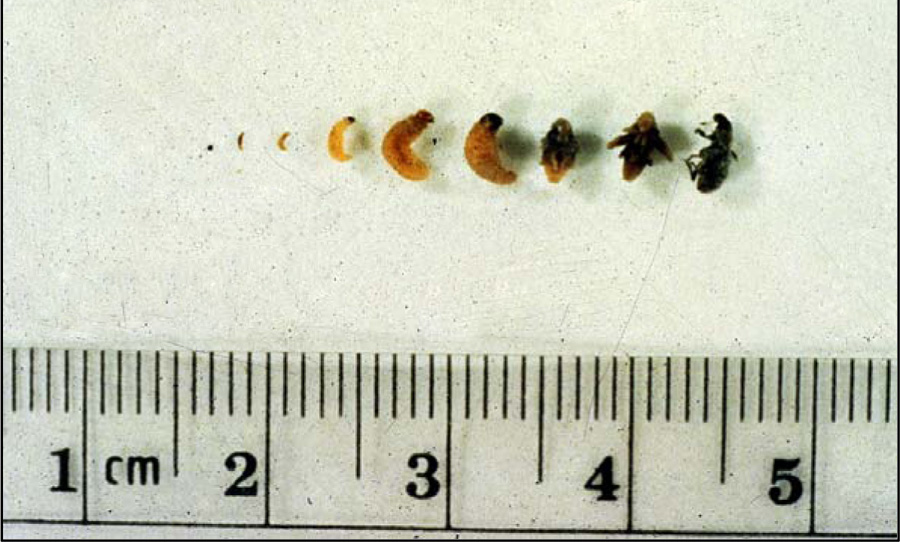
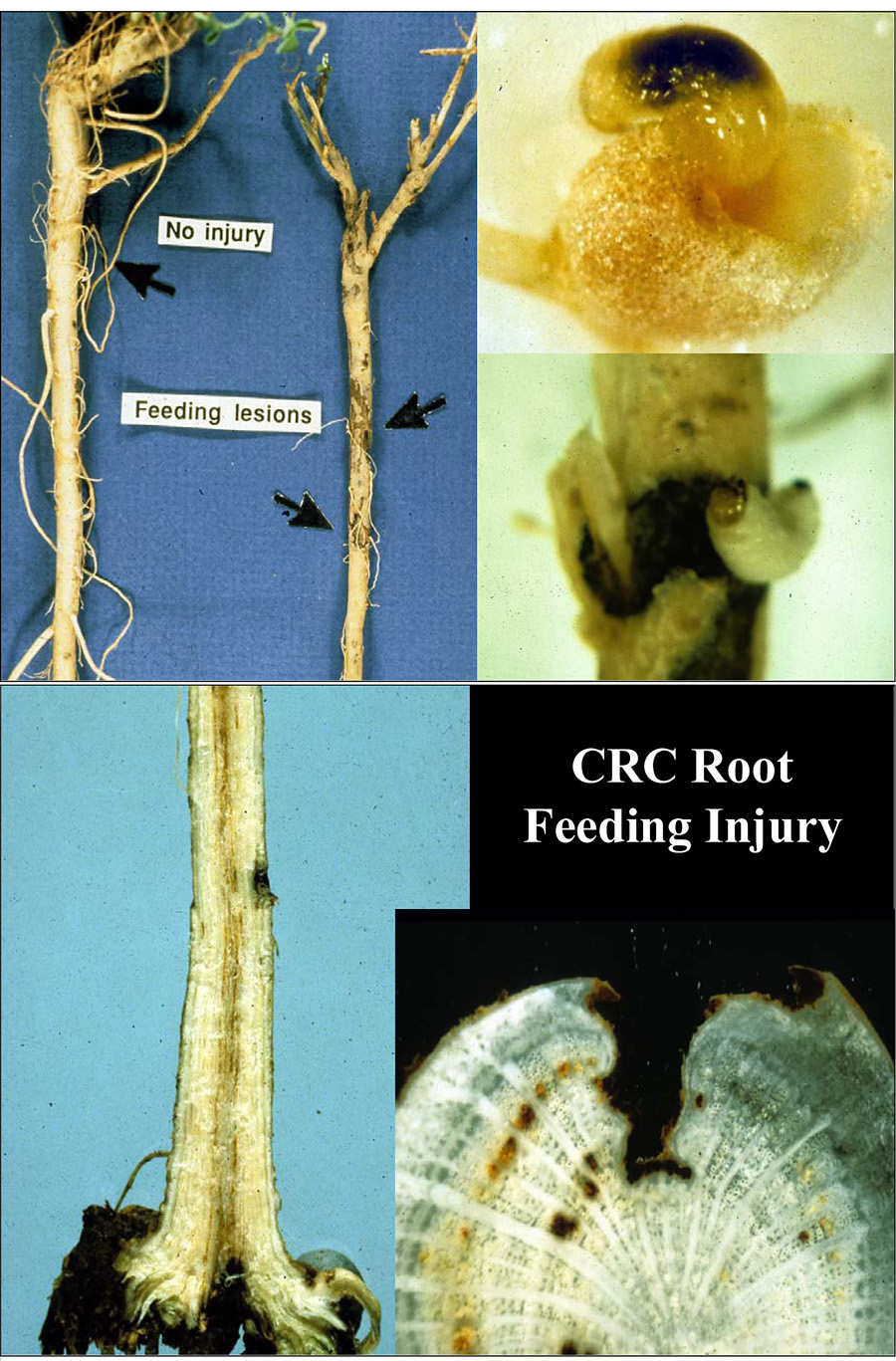
|
Impact of Environment on Population Dynamics: This insect has a single generation per year. Water logged soils during the larval stage will cause significant mortality to the larvae feeding on the roots. Otherwise, there is little known additional impact of the environment on the population dynamics. |
Impact of Environment on Crop Damage: Loss of roots reduces the plant’s ability to extract water from the soil. During times of dry soils, CRC damaged plants become water stressed much sooner than undamaged plants. Persistent water stress results in loss of yield and plant death. |
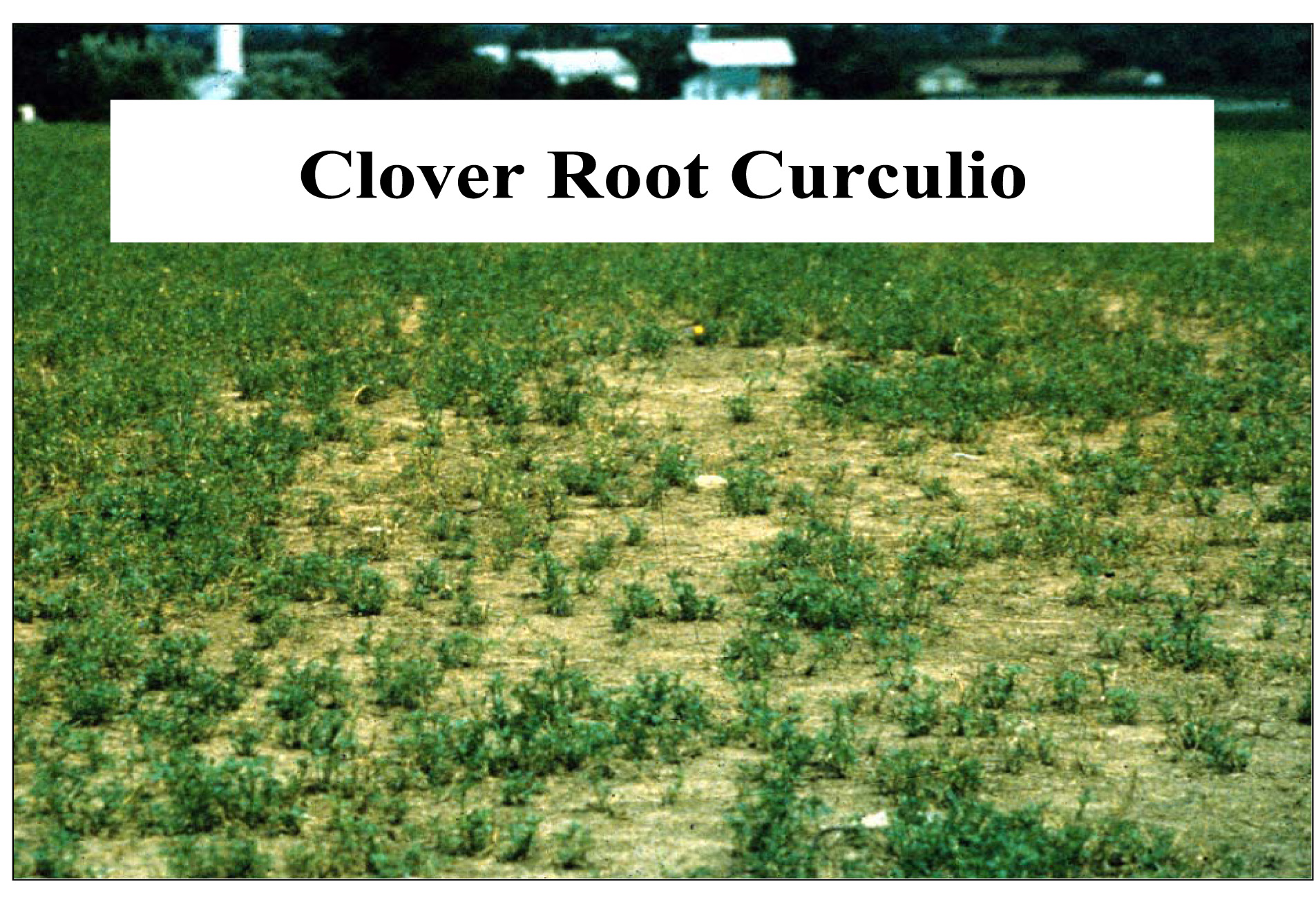 |
Management: Currently, there are no effective strategies to manage CRC in NY and NE alfalfa. Research is underway to develop a line of resistant alfalfa, but deployment of any resistance is years away. |
Potato Leafhopper |
|
Pest Type: Primary |
|
Feeding Habit, Host Range, Injury Type, Symptom, Damaging Stage: Potato leafhopper has a host range of over 200 plant species, including alfalfa, and potatoes. Hosts also include tree species such as willows, maples and hickories. This is a migratory insect which overwinters in the southern US and arrives in the Northeastern US in the spring around Memorial Day on thunderstorms. |
Lifecycle: In the southern US, females which have overwintered on southern yellow pines move off the pine trees around the first of March and begin laying eggs on a wide array of hosts from legumes to trees like willows and hickories. After 1-2 generations on the local hosts, the newly emerged adults migrate north on the warm southern winds during late April and early May. Spring migrants typically arrive in the upper Midwestern states around May 1 and typically arrive in Upstate NY around Memorial Day. Arriving migrant females begin laying eggs immediately on the wide array of hosts with alfalfa being the most important host to field crop production. During the growing season in NY and the NE, there are 3- 4 generations. All life stages are damaging to the host with the nymphs having a greater impact because they are flightless and feed within a localized area. Plant damage is a result of the injection of a salivary toxin into the leaf tissue during feeding from the insect’s piercing/sucking mouth parts. Low levels of the toxin in the leaf causes the restriction of the vascular tissue in the leaf and causes photosynthesis to shut down. A higher toxin level results in leaf yellowing, burning of the leaf margins and leaf death. Over wintering adults start departing from the NE US for their return trip to the overwintering area in the southern US in mid-August and all of the fall migrants have departed by September 10 in most years.
With insects being cold blooded, temperature drives the speed of all body functions. A warmer growing season will shorten the duration of each life cycle and a greater number of generations will occur during the growing season. A cooler growing season will lengthen the duration of each life cycle and reduce the number of generations during the growing season. |
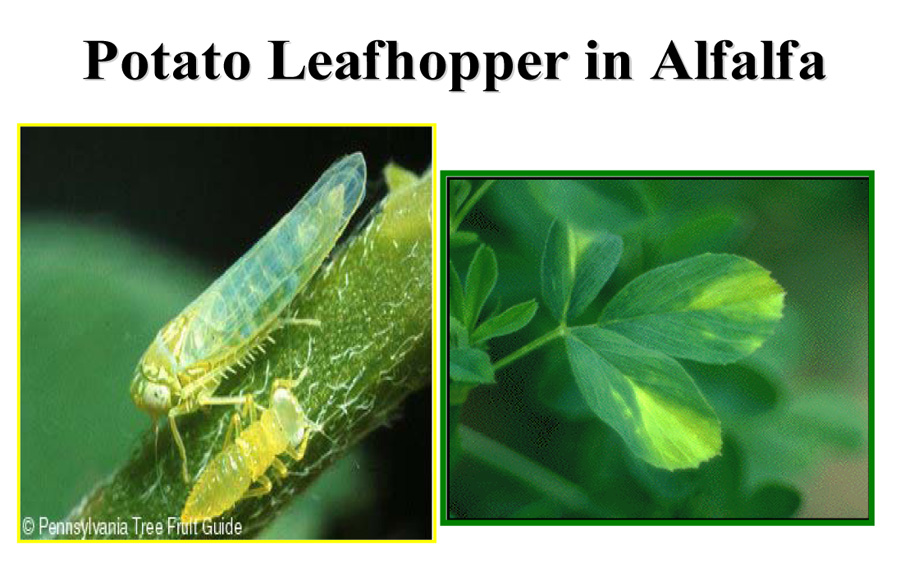
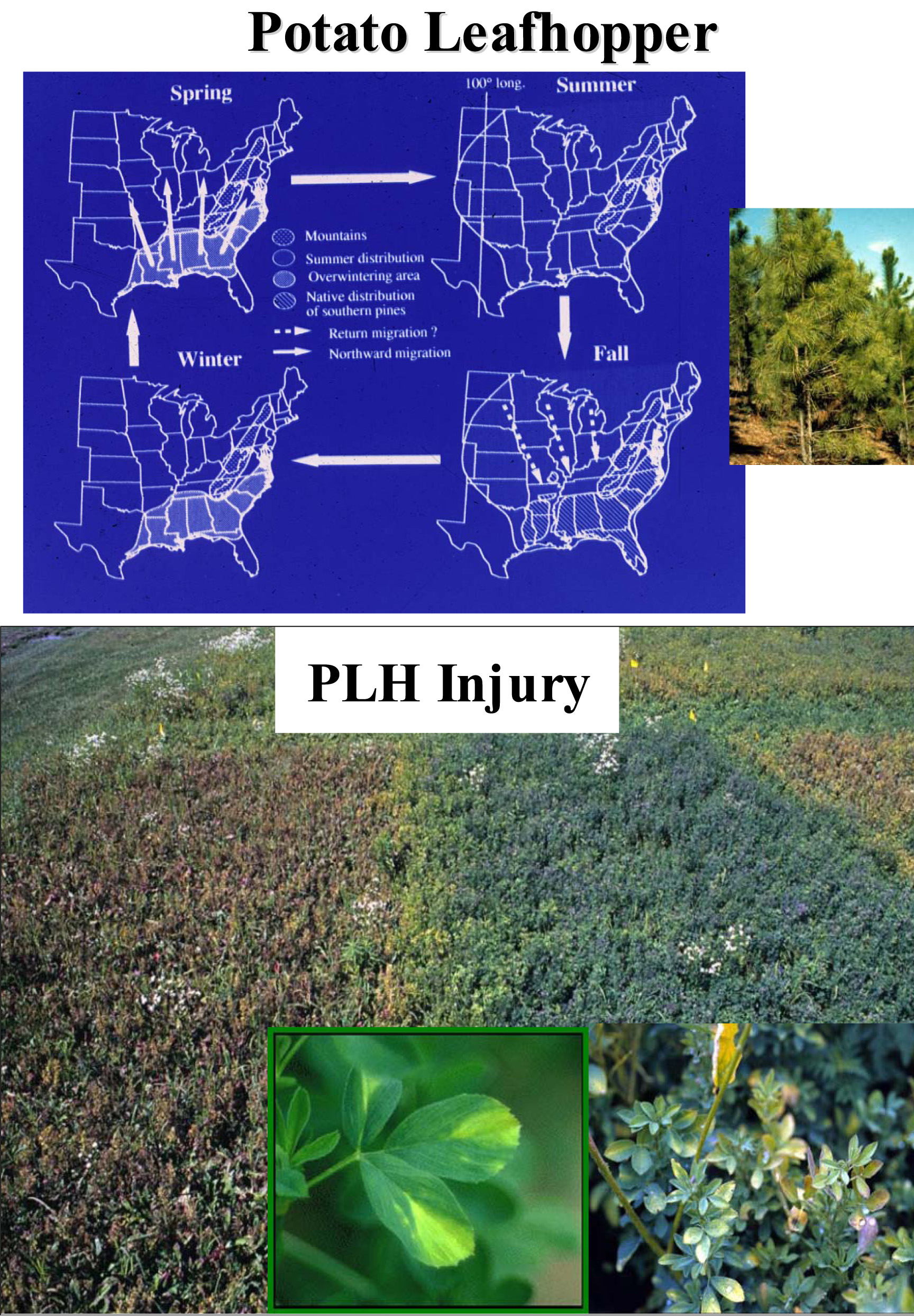
|
Impact of Environment on Crop Damage: Water stress conditions increase the impact of potato leafhopper damage on the yield of alfalfa. Increased transpiration and decreased photosynthesis from potato leafhopper feeding magnifies the impact of water stress on the plant and decreases the yield to a lower level than would be expected with the water stress alone. |
Management: With the current effective array of PLH resistant alfalfa varieties, all new alfalfa stands should be planted to one of the new resistant varieties, regardless if the planting is clear seeded alfalfa or an alfalfa-grass mixture. With the yield impact of potato leafhopper on susceptible alfalfa, the cost of scouting and the cost of insecticide treatment, the planting of susceptible variety makes no business or pest management sense.
PLH resistance in alfalfa is due to the presence of glandular hairs on the stem and leaves. These hairs inhibit feeding and the laying of eggs in the stems of the plant. The resistance is most effective on the small leafhopper nymphs.
Effective management of PLH in susceptible alfalfa stands requires weekly scouting with a sweep net and the use of the treatment guidelines listed below and in the current version of the Cornell Guidelines for Field Crop Production. When properly applied, insecticides are very effective in the control of PLH. |
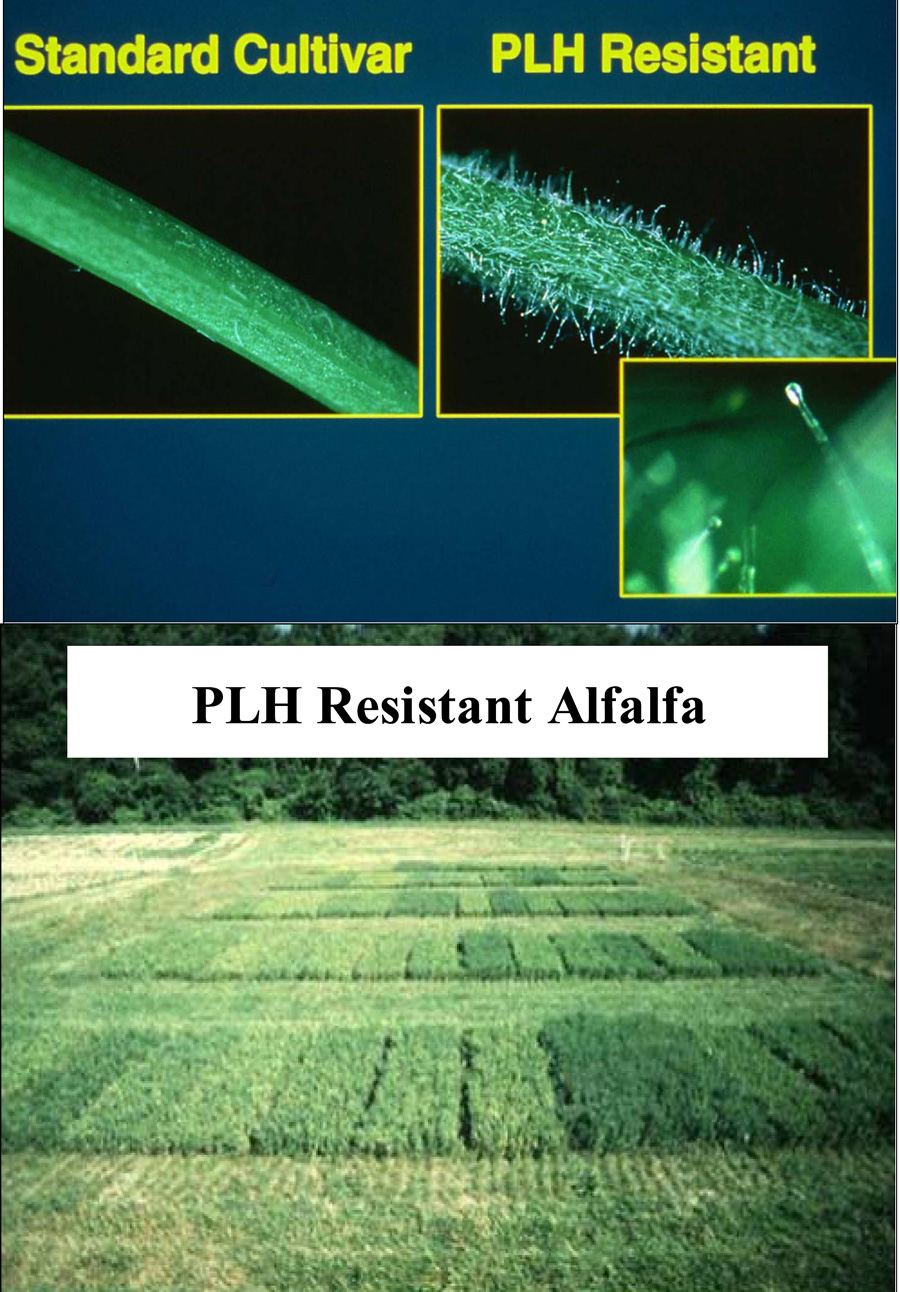 |





























